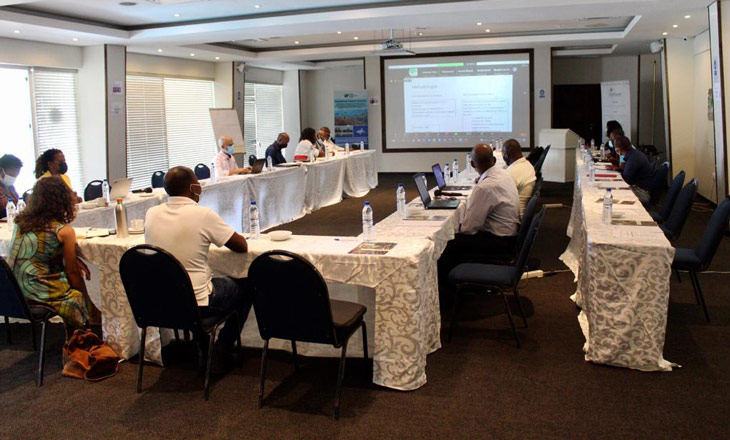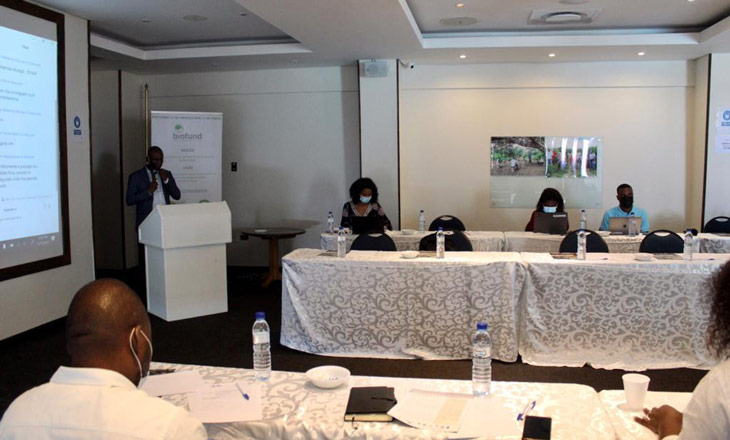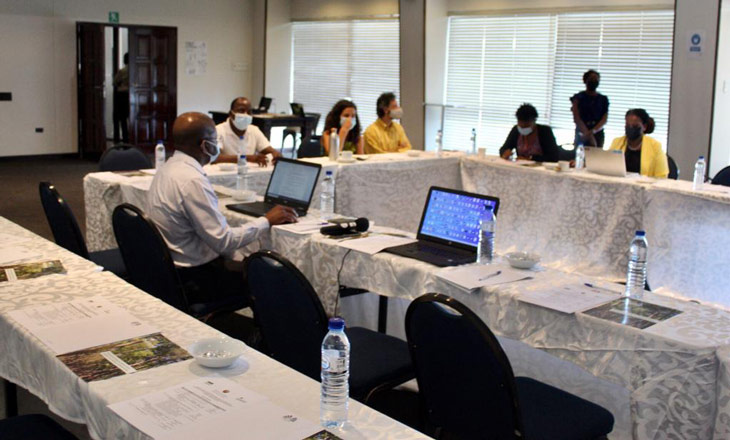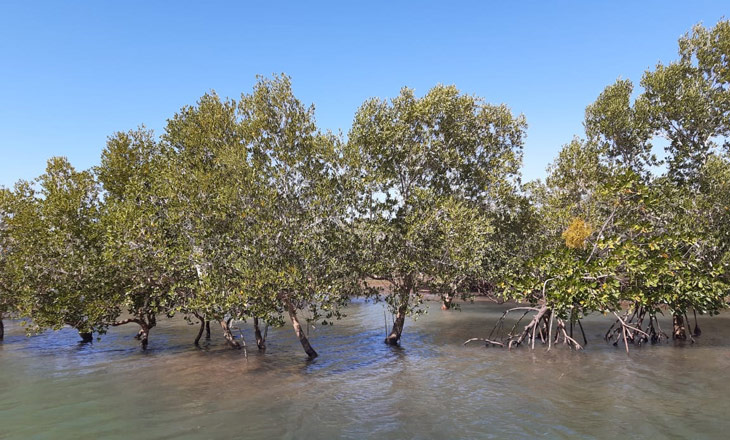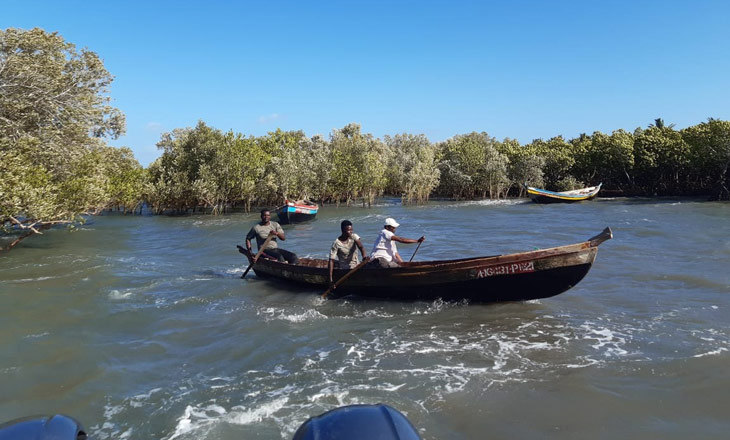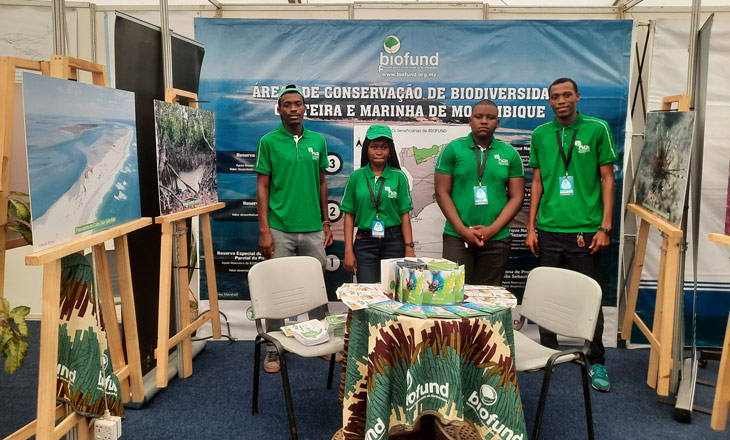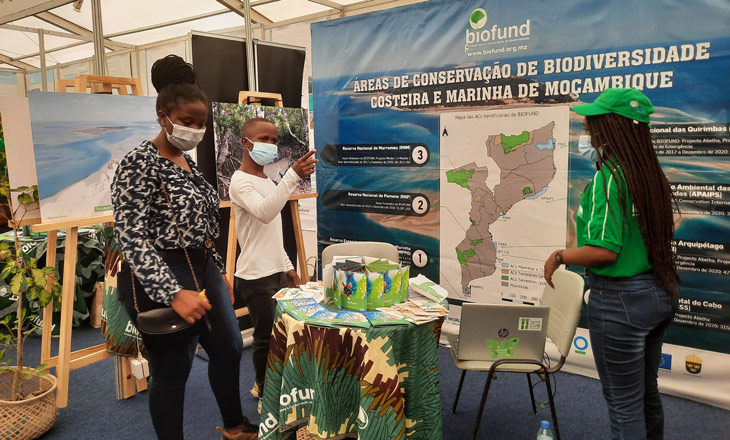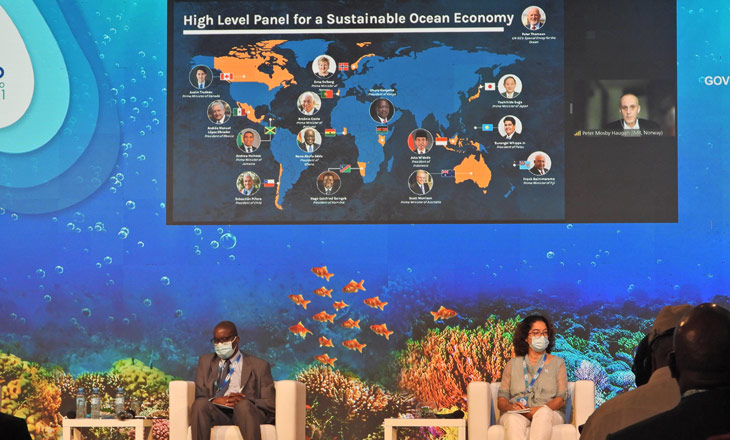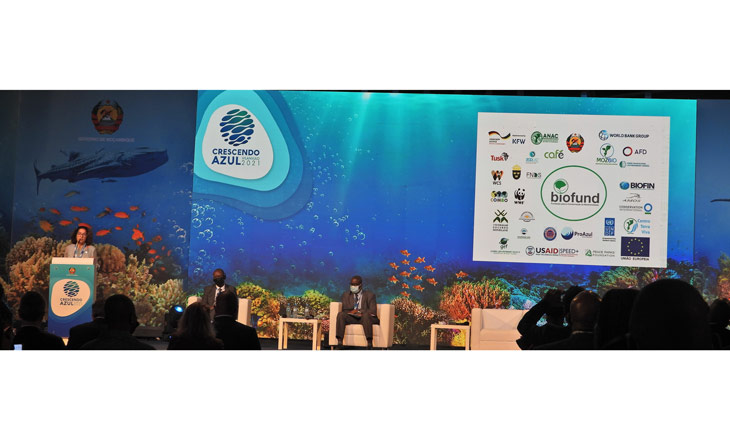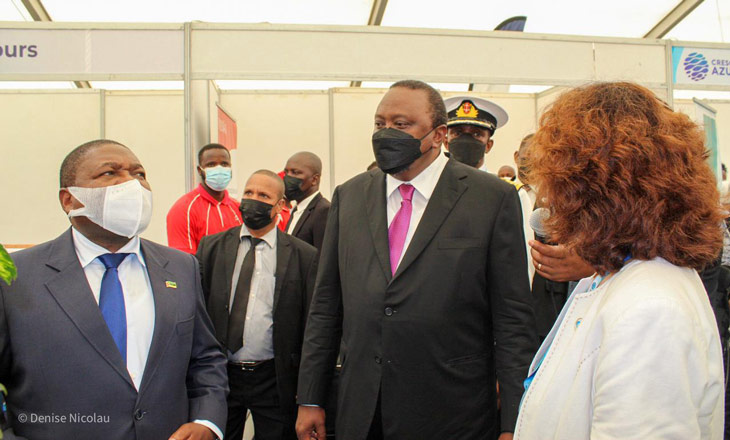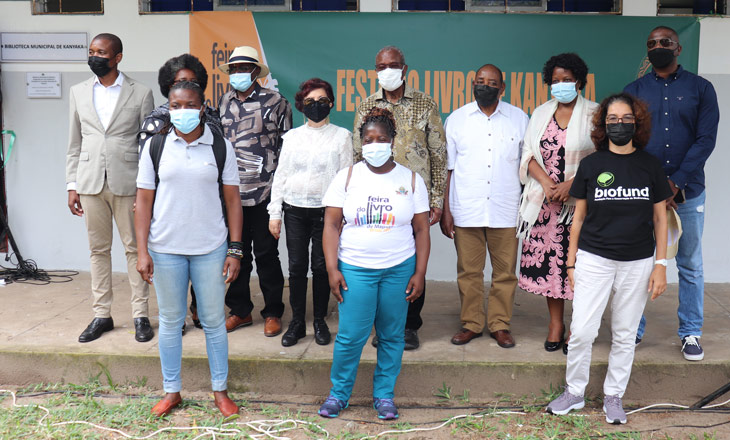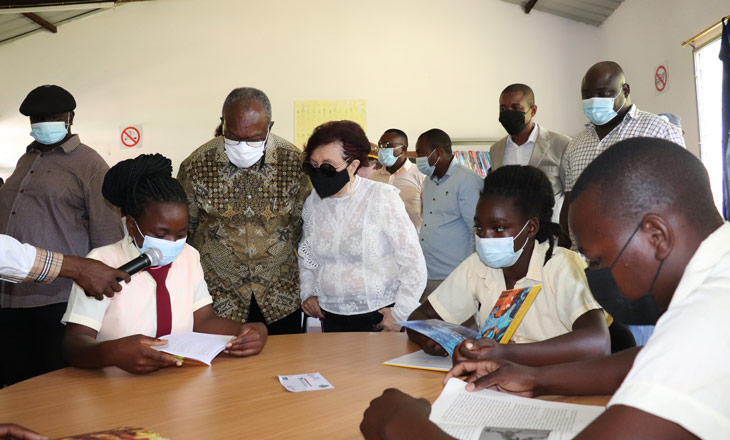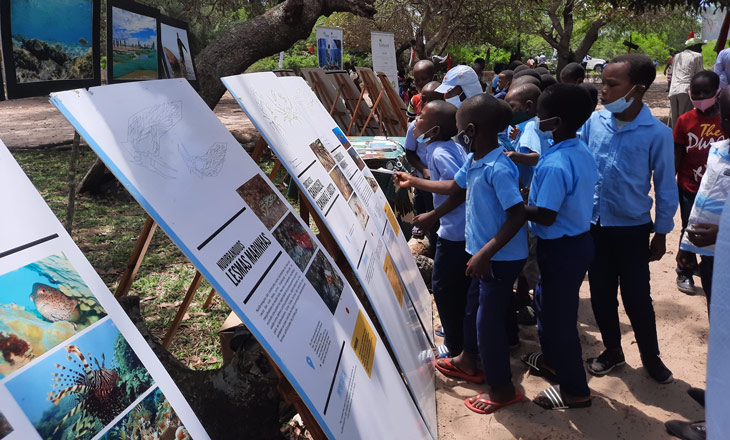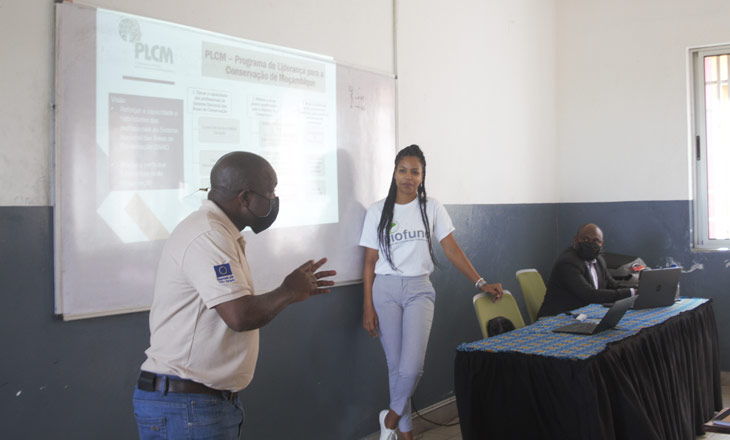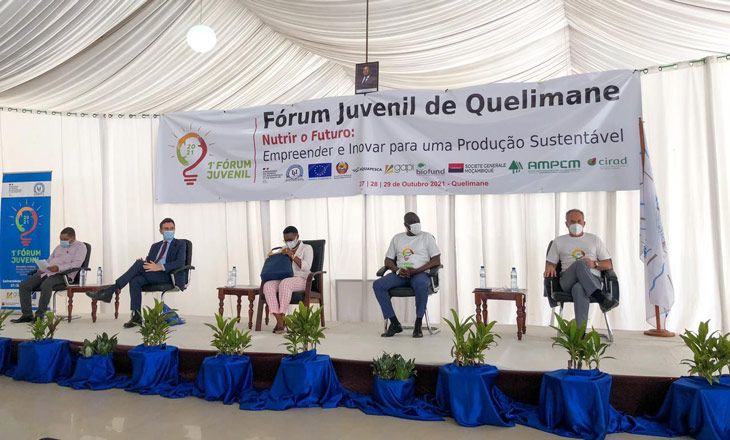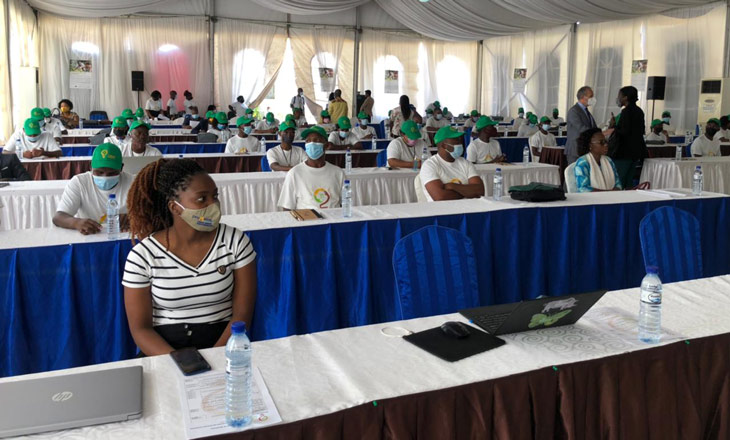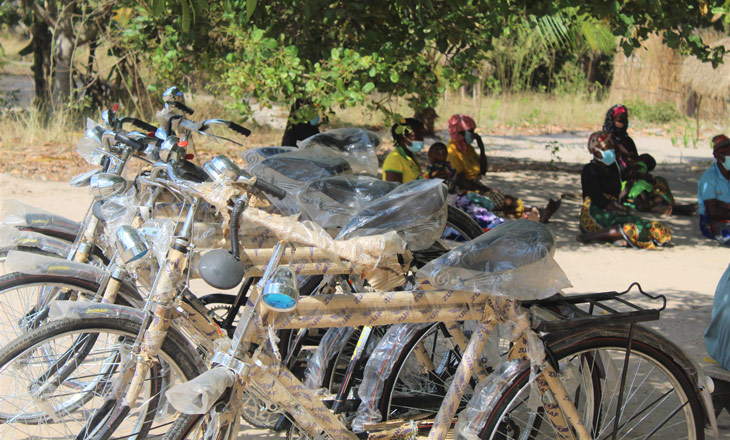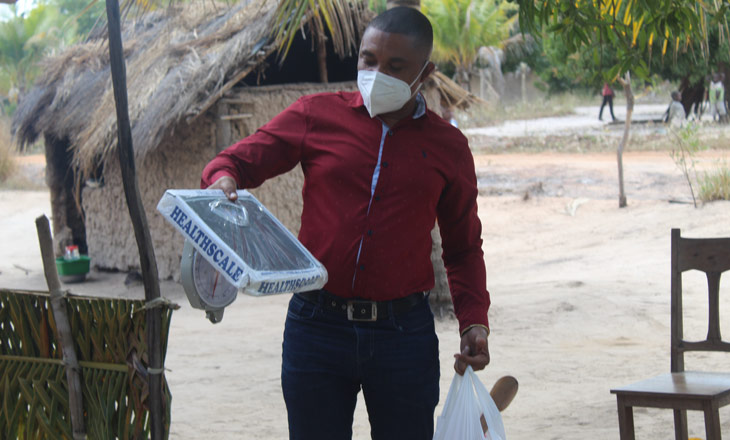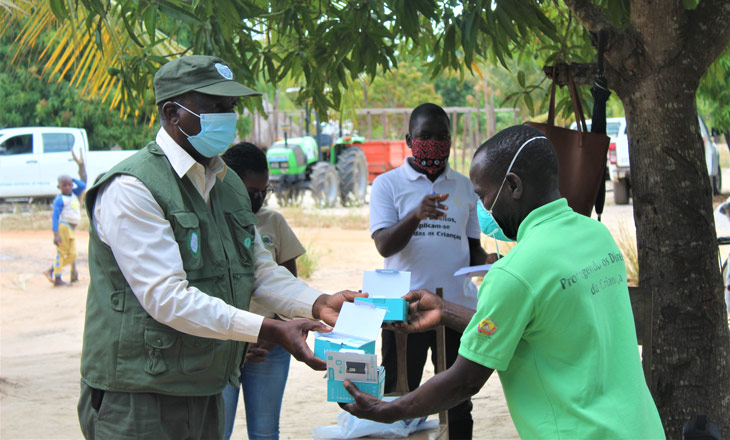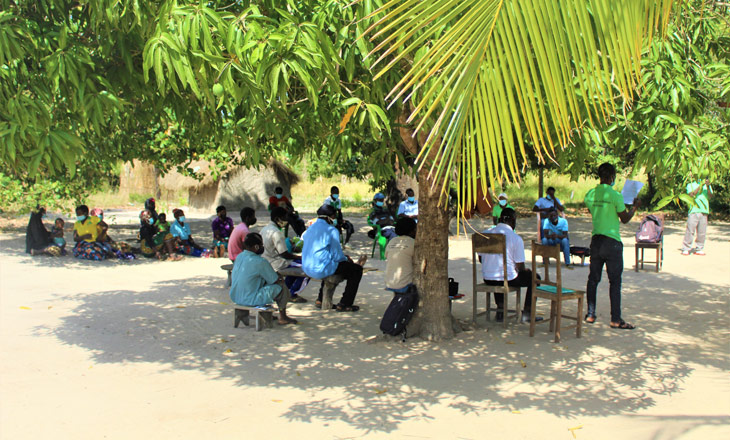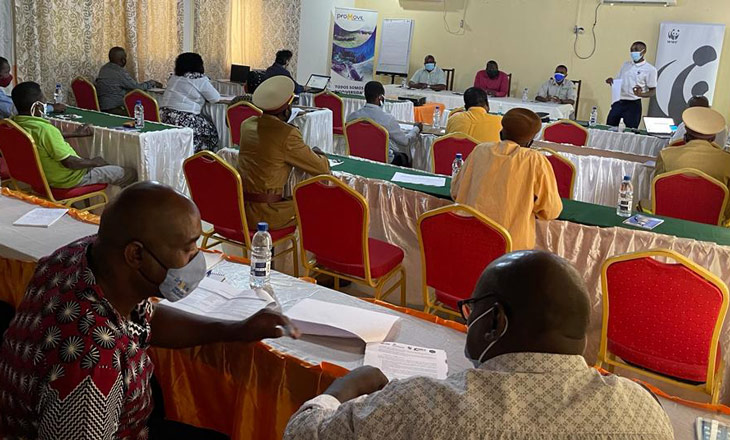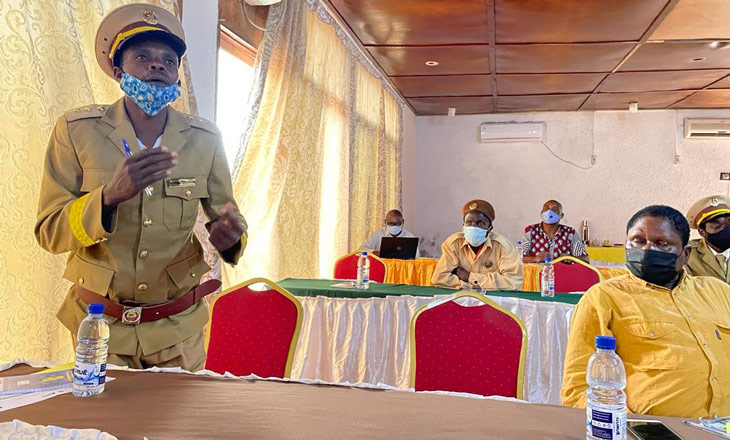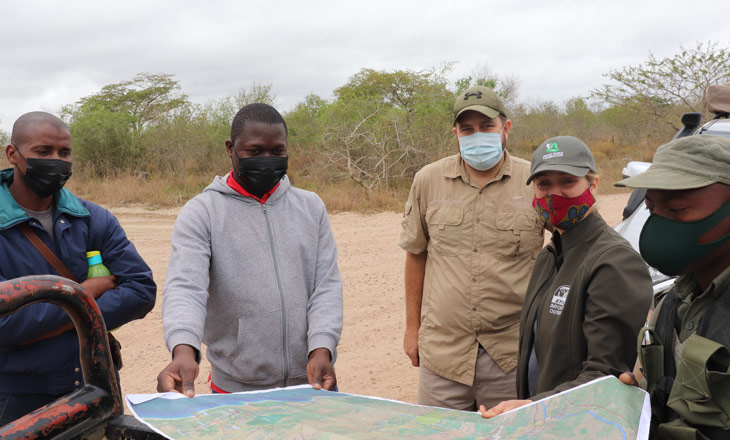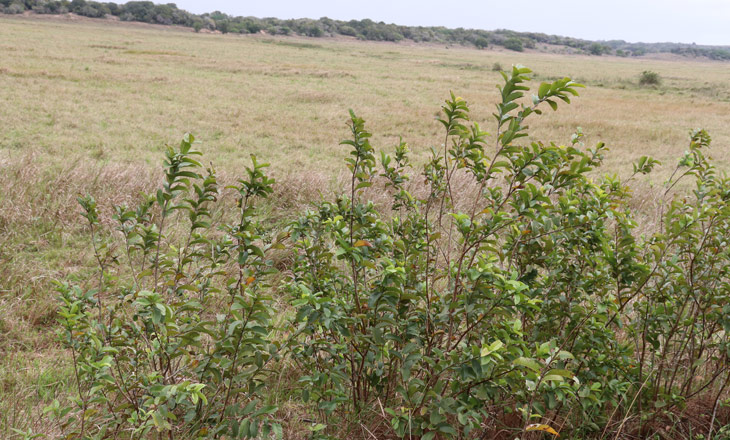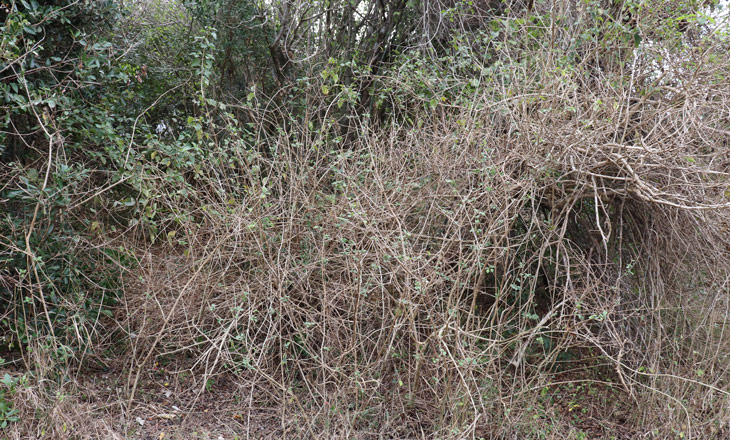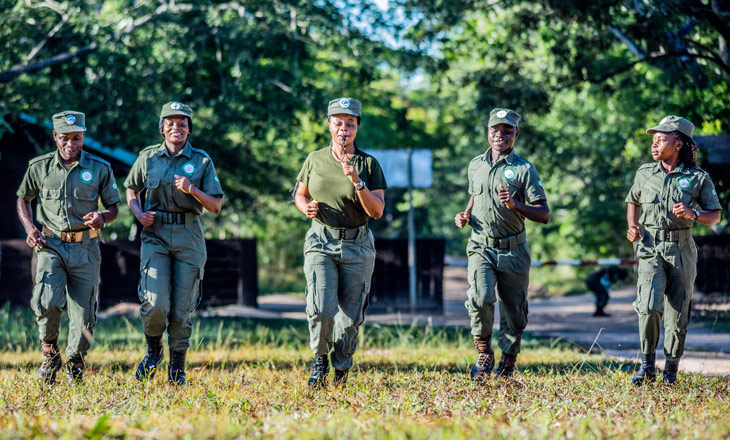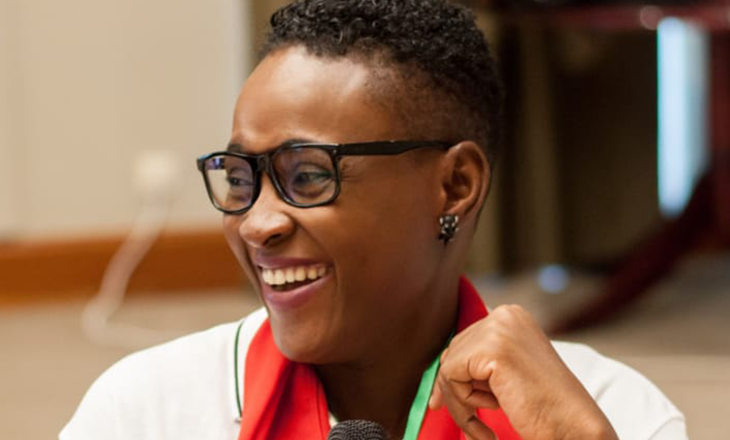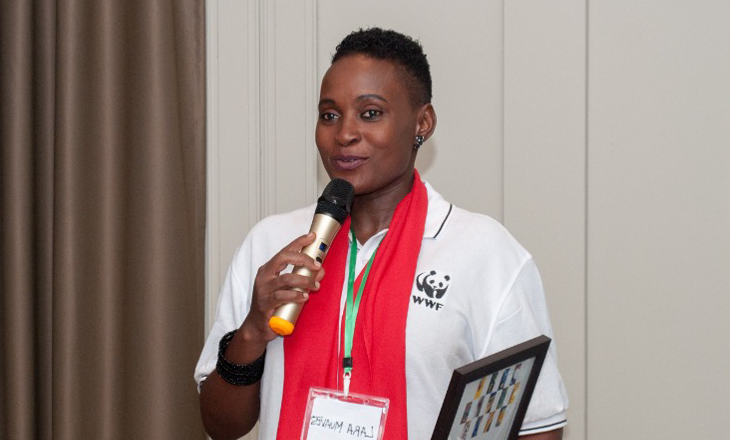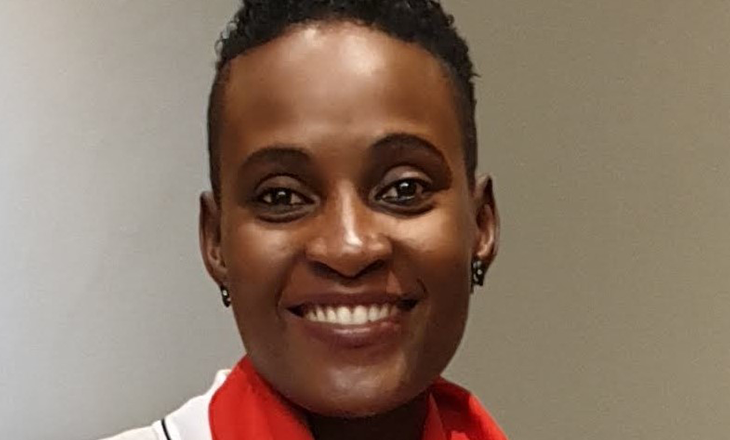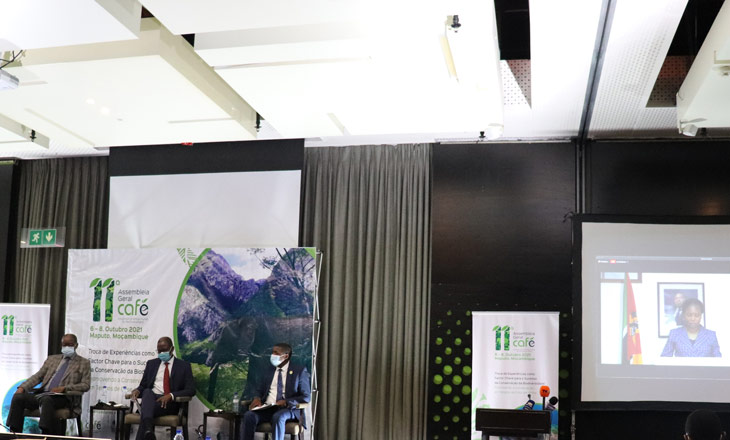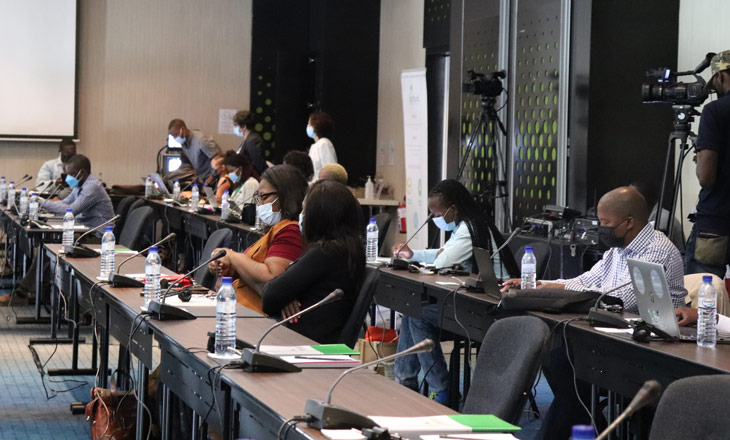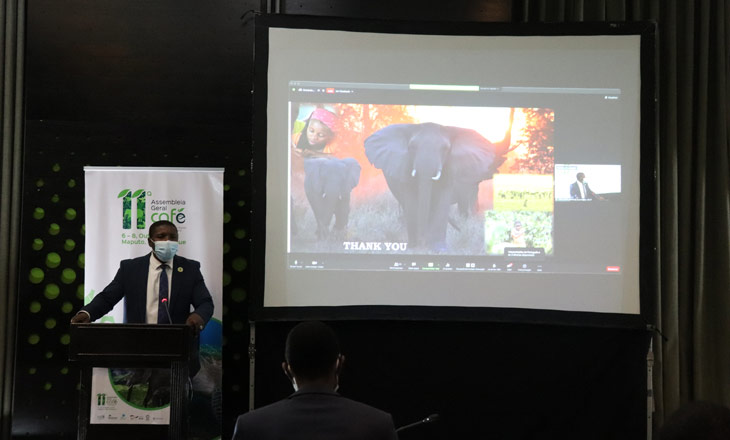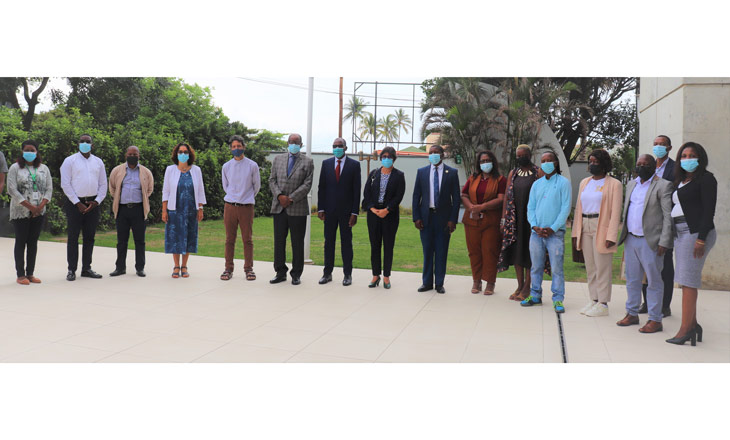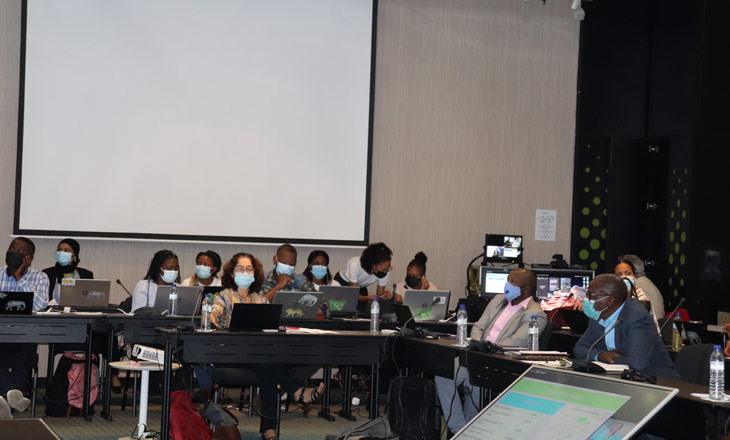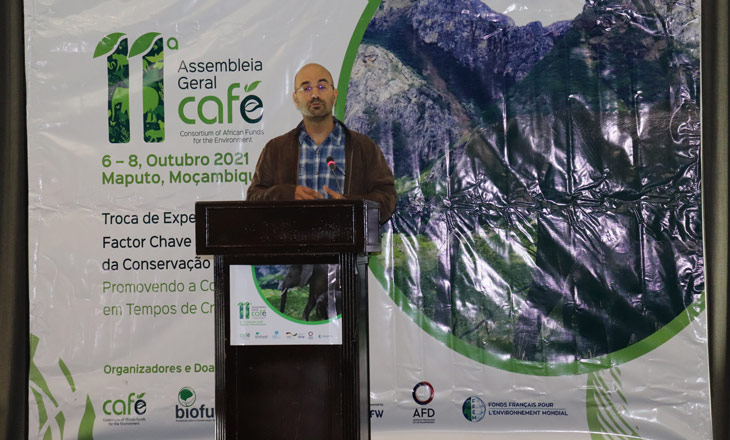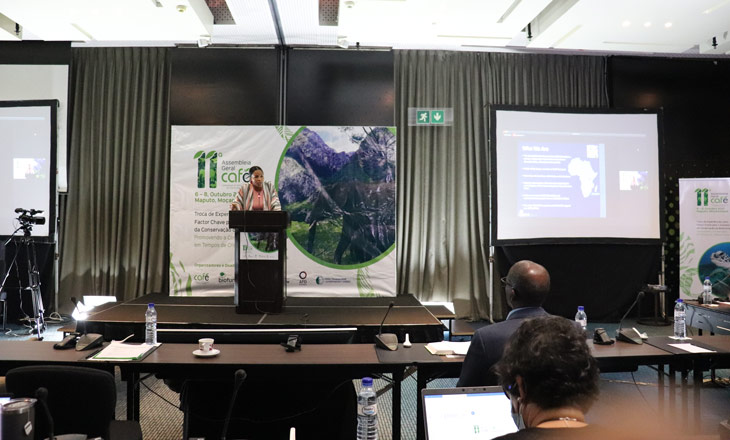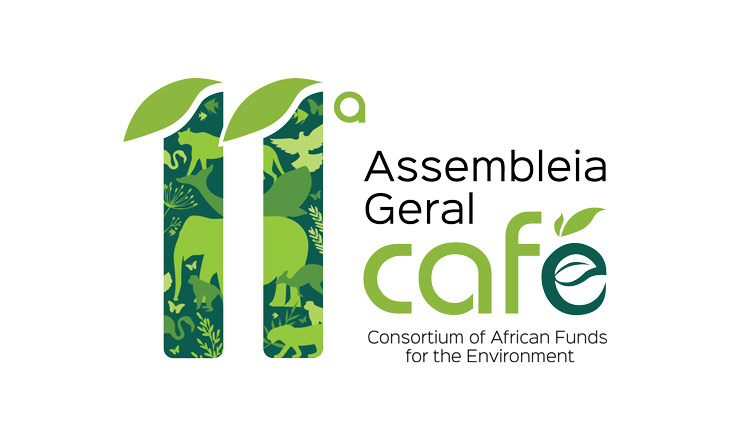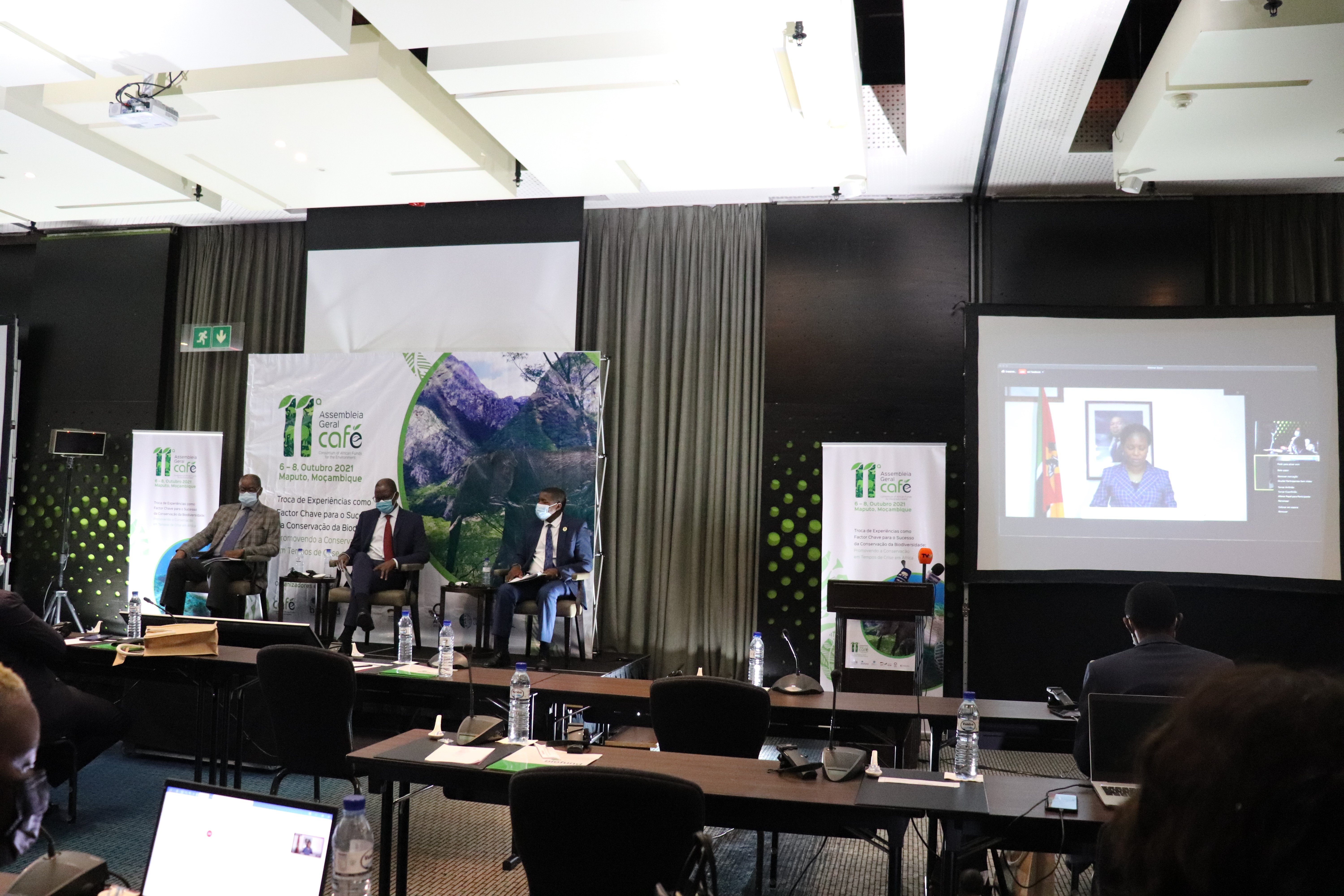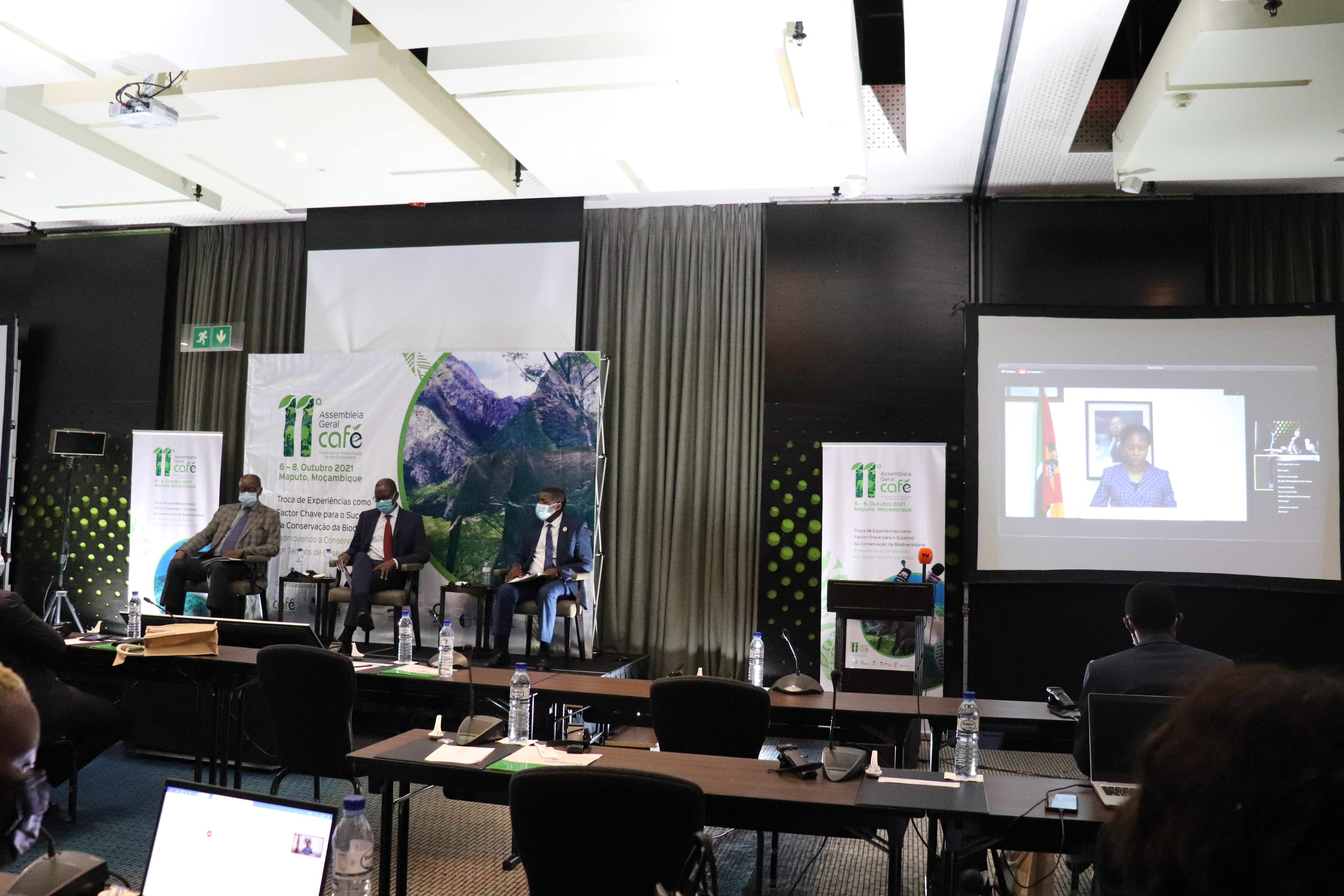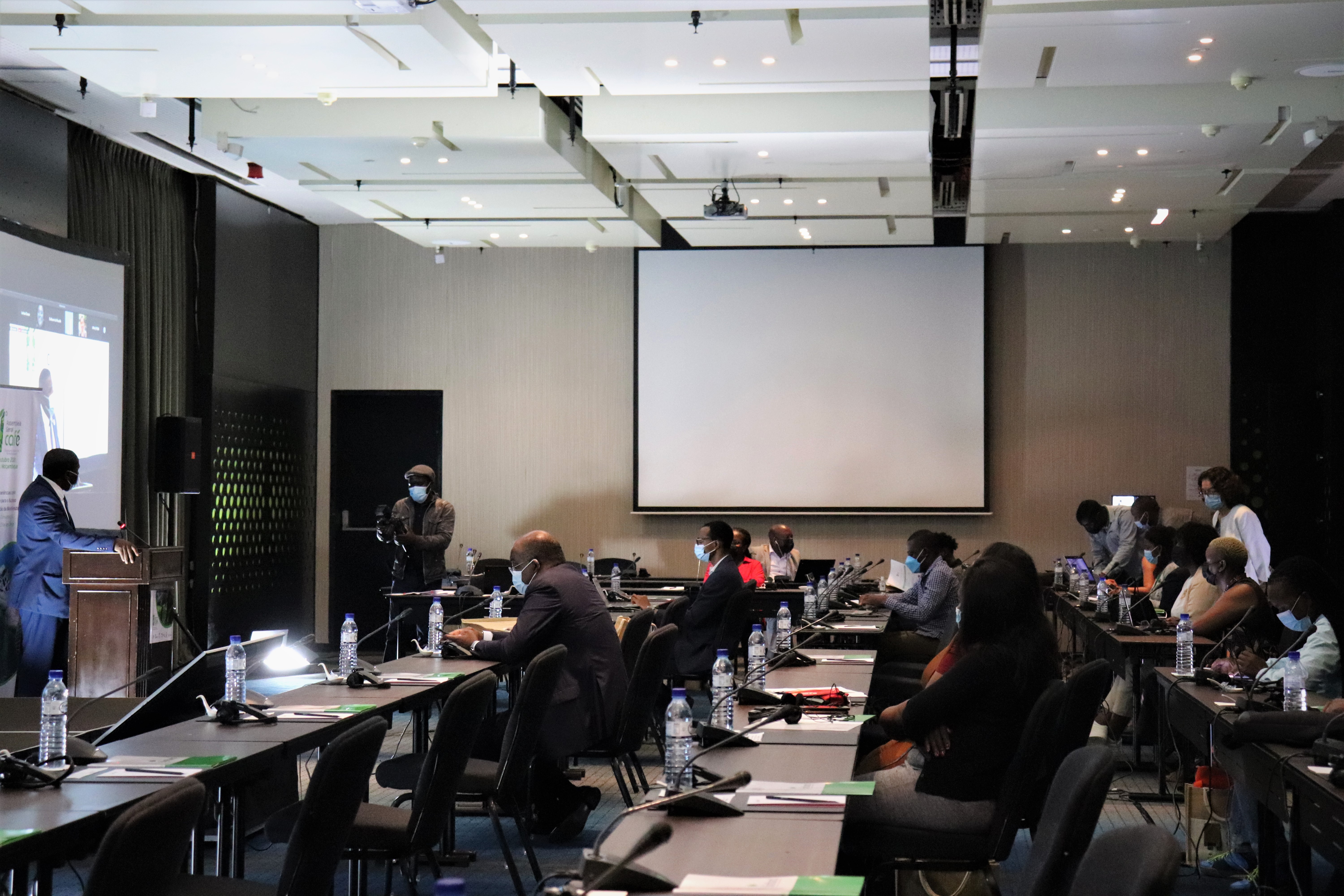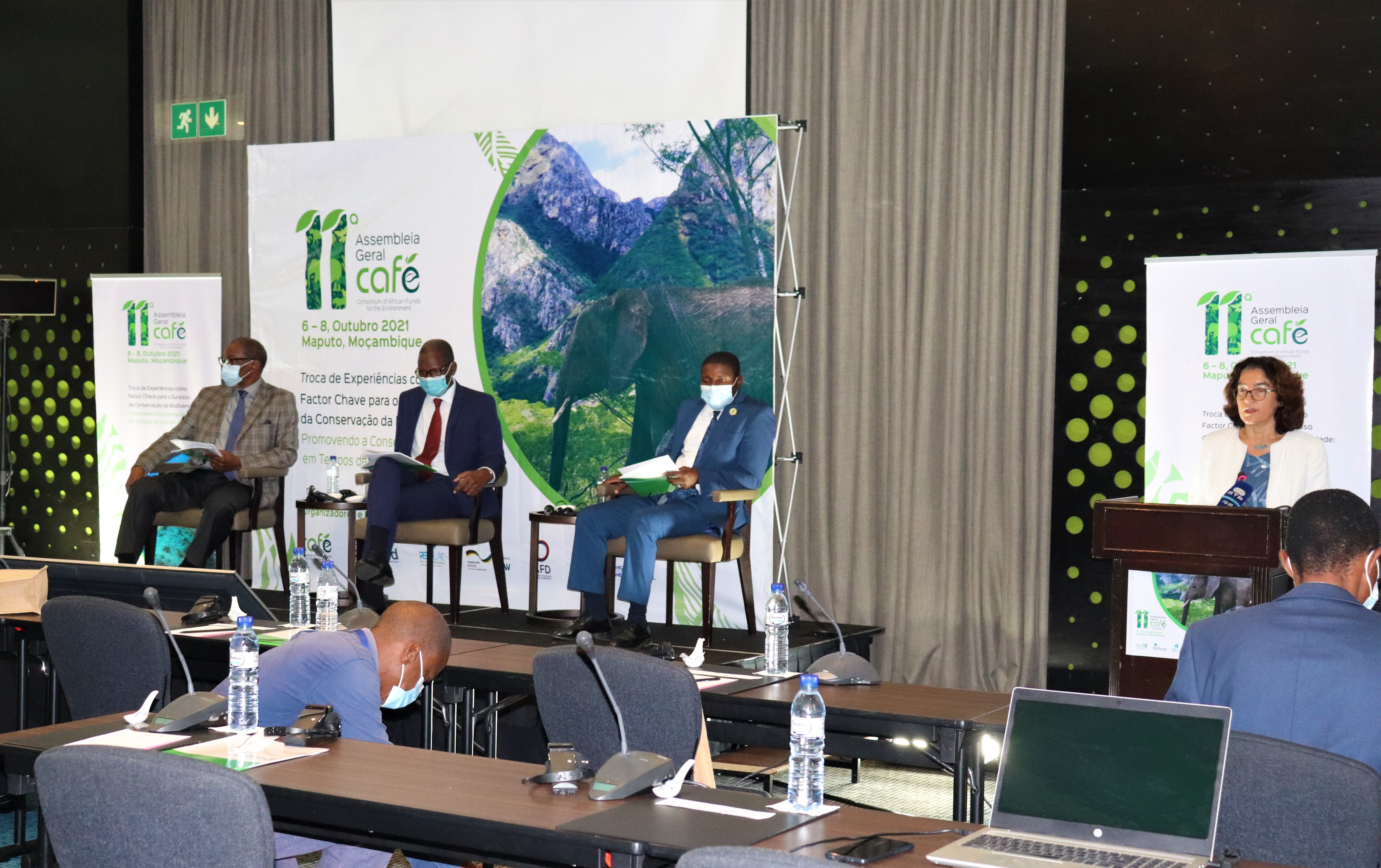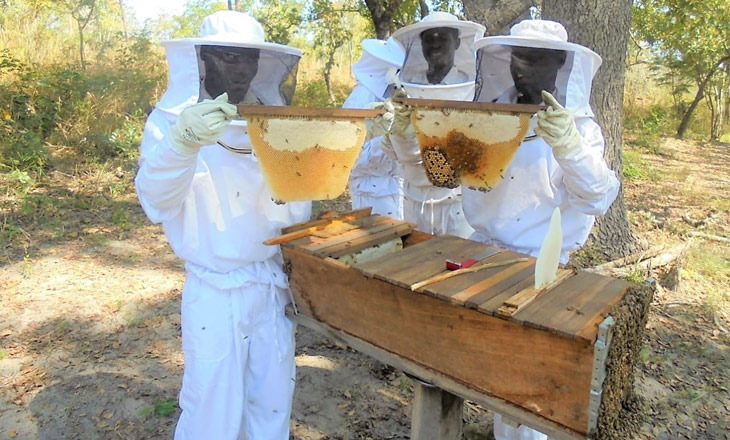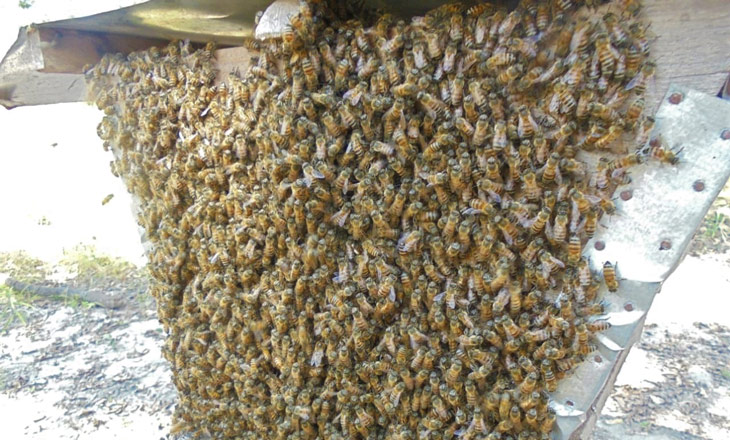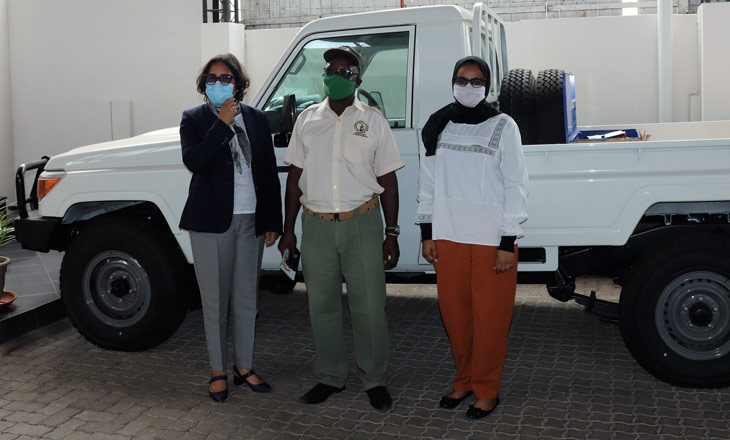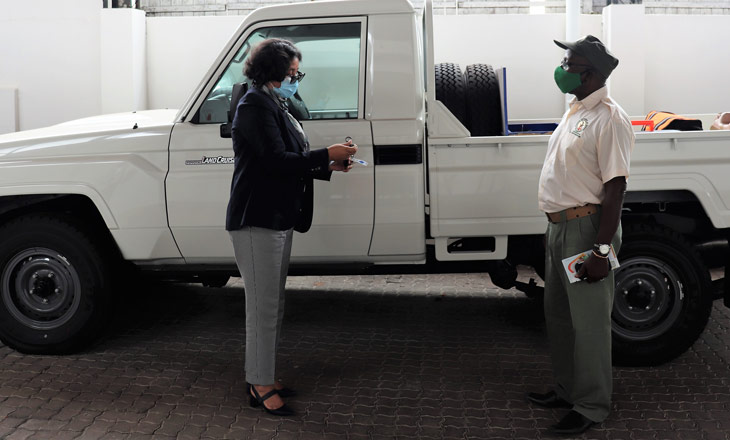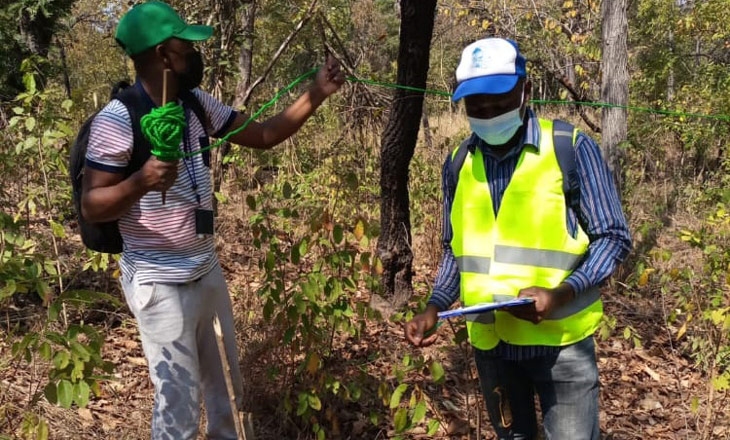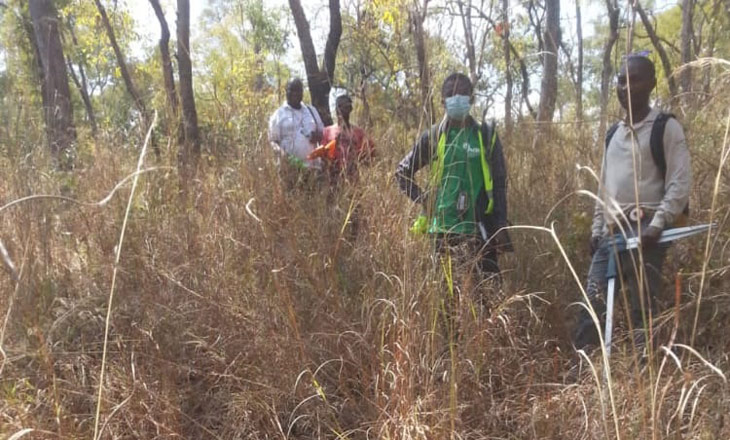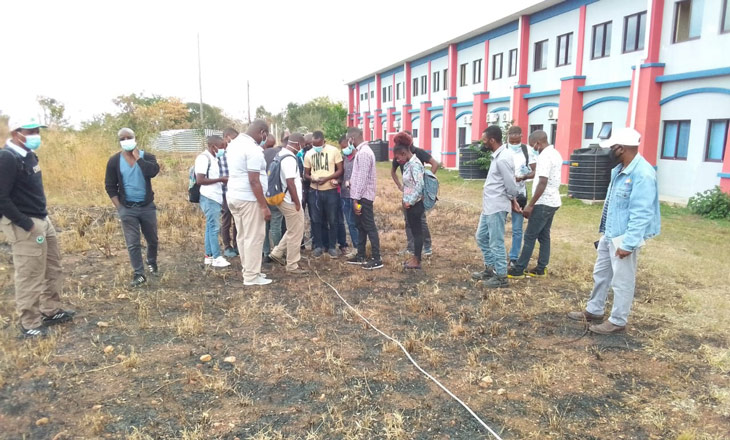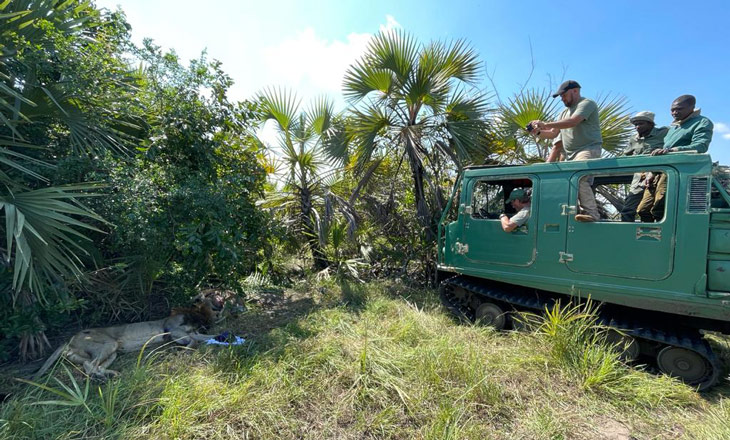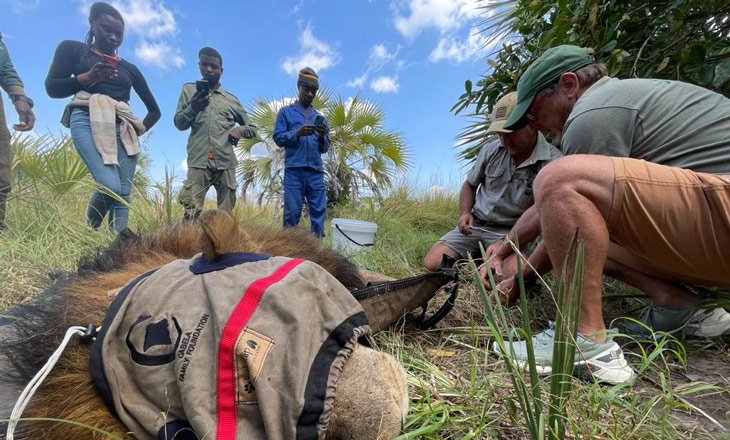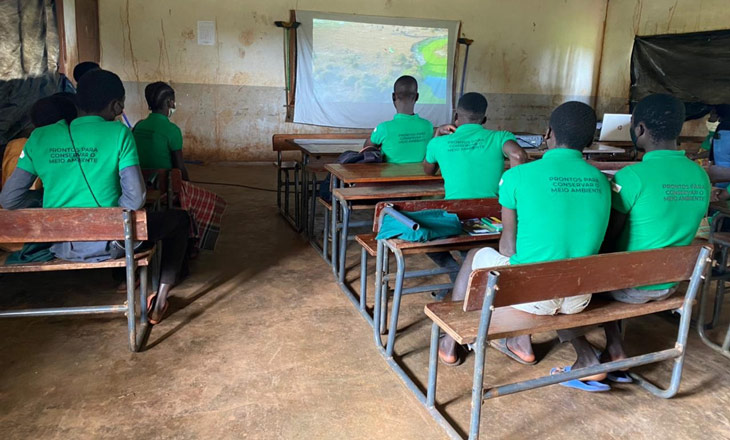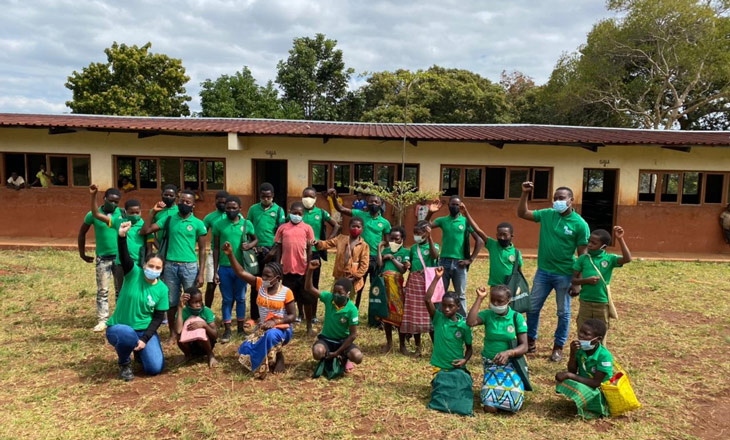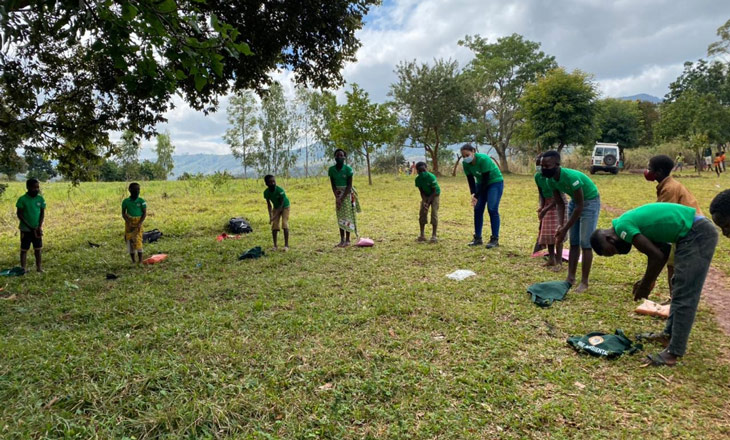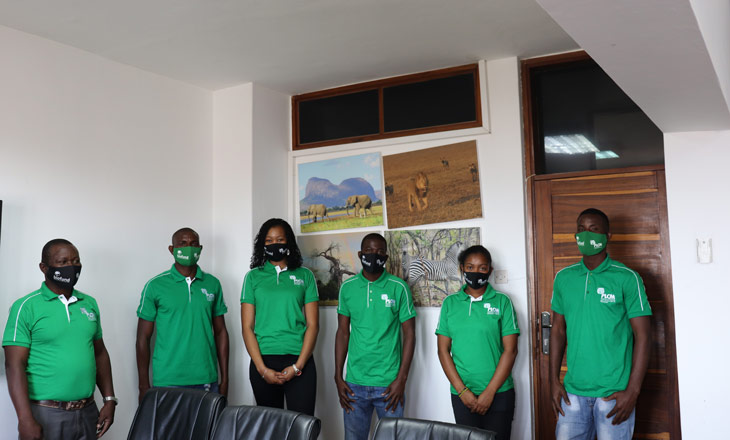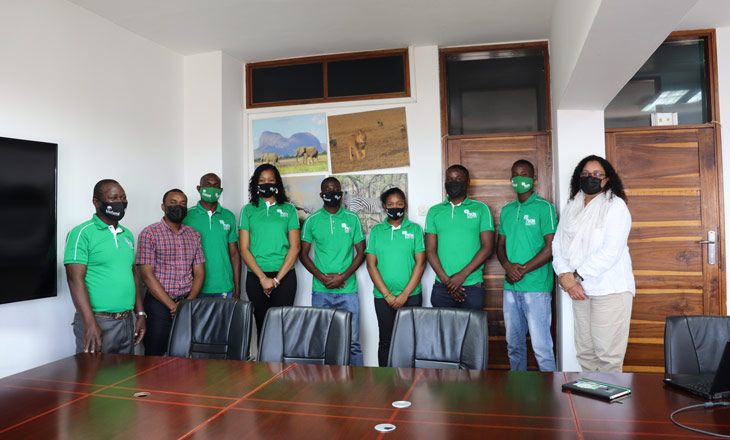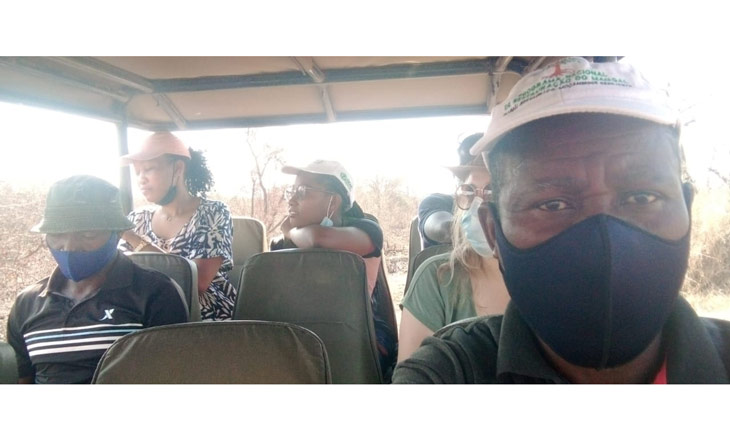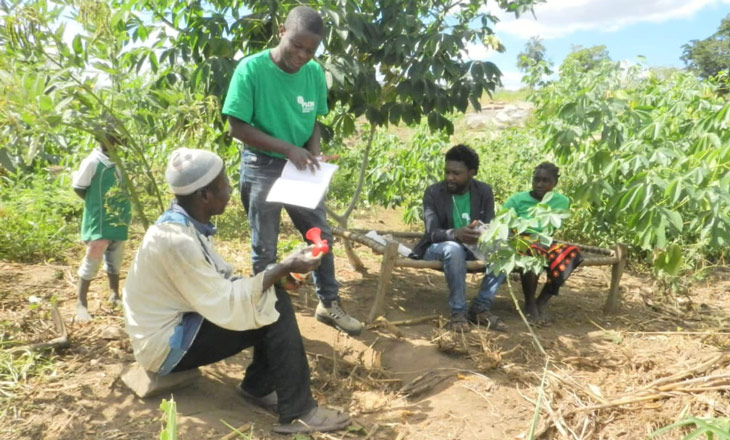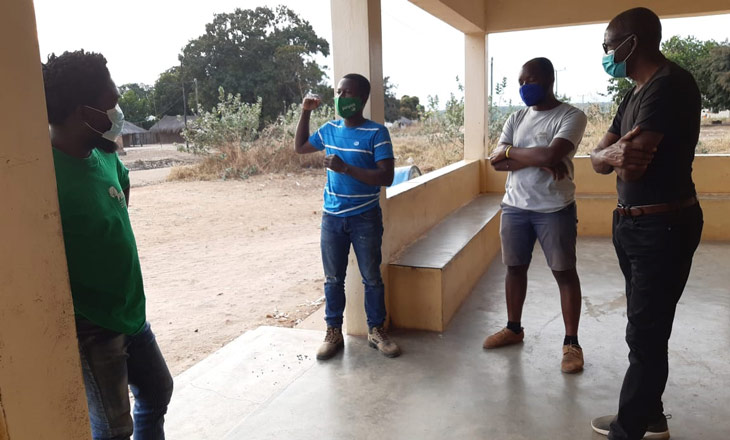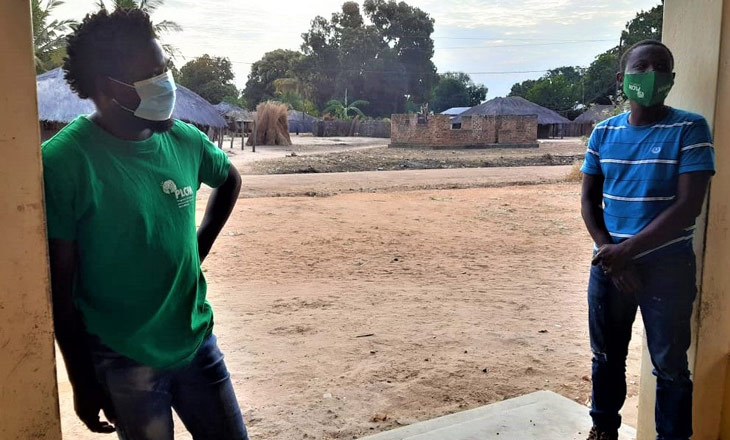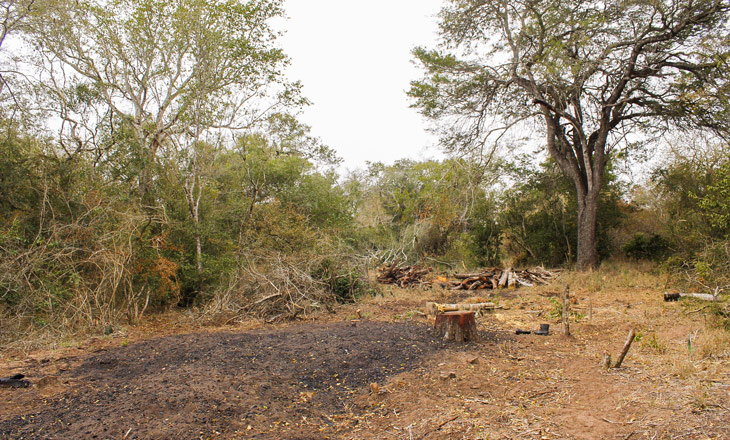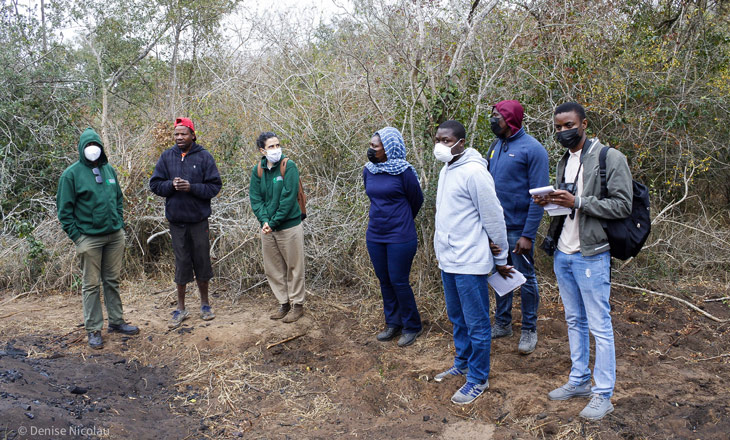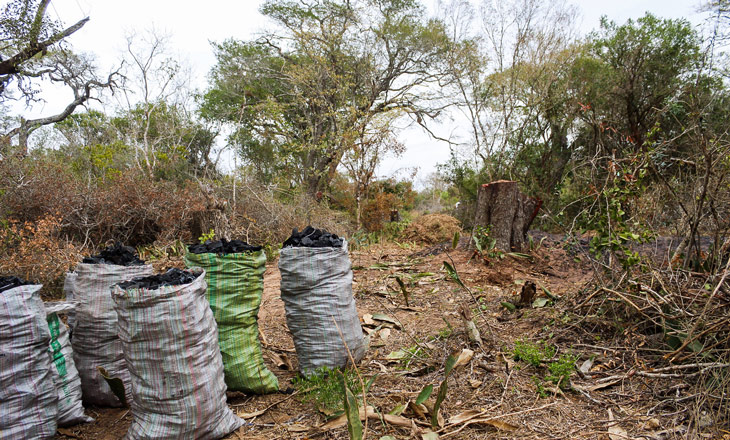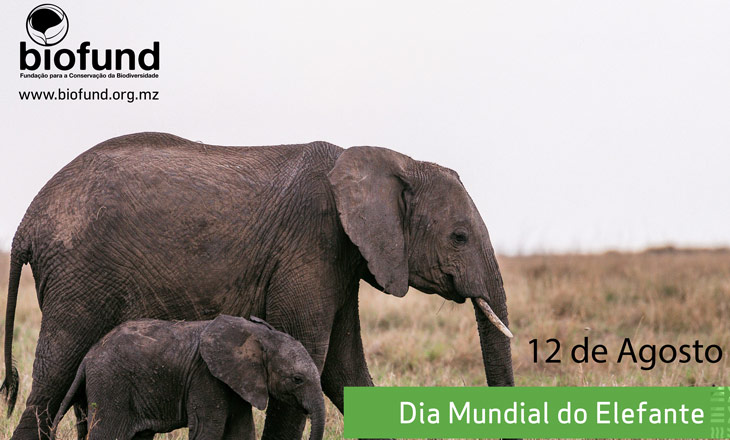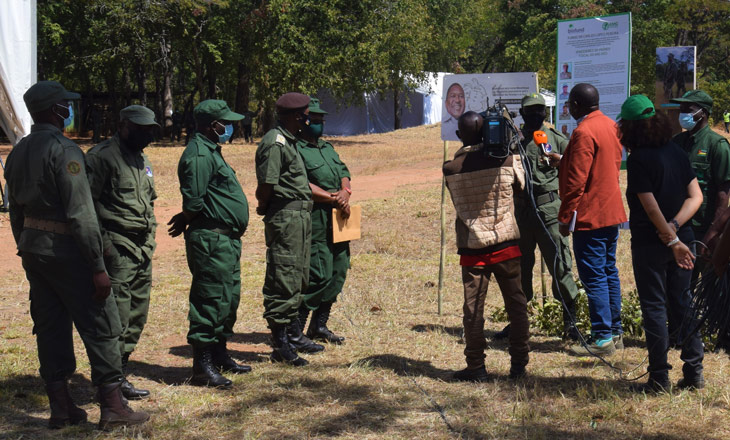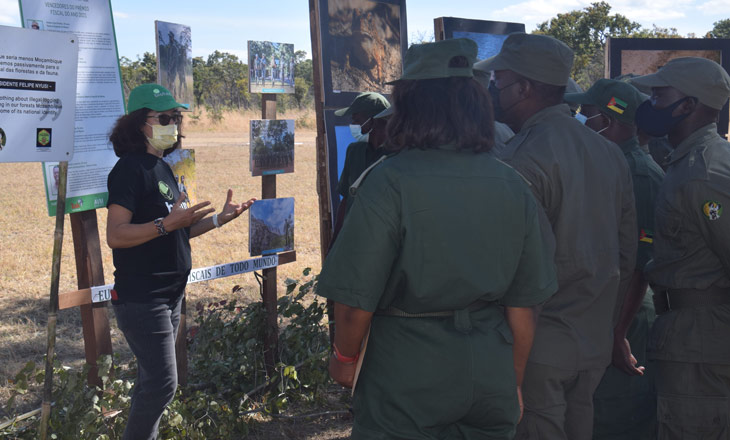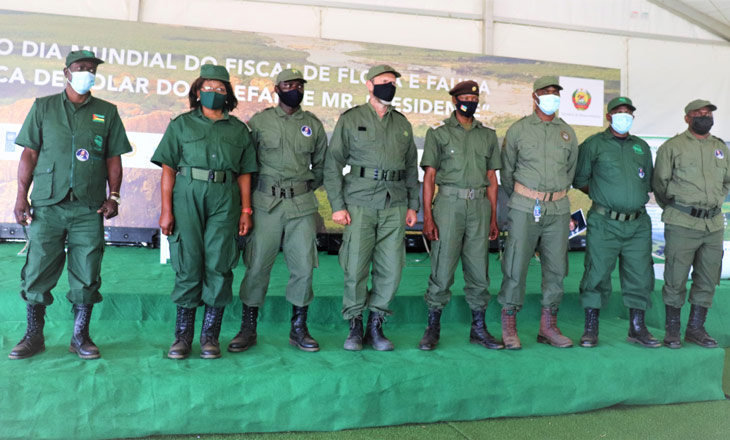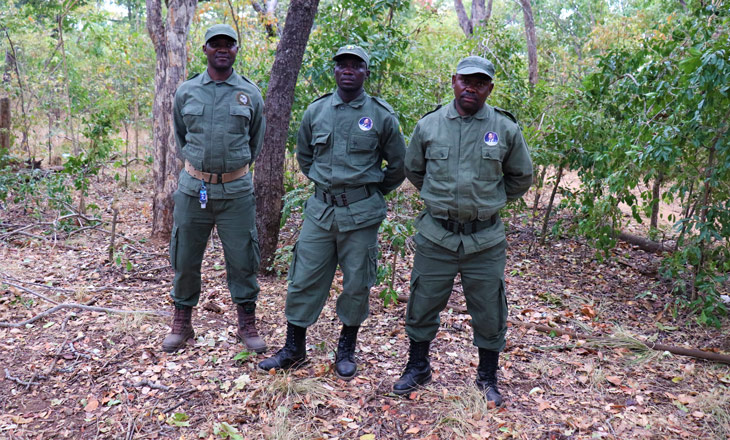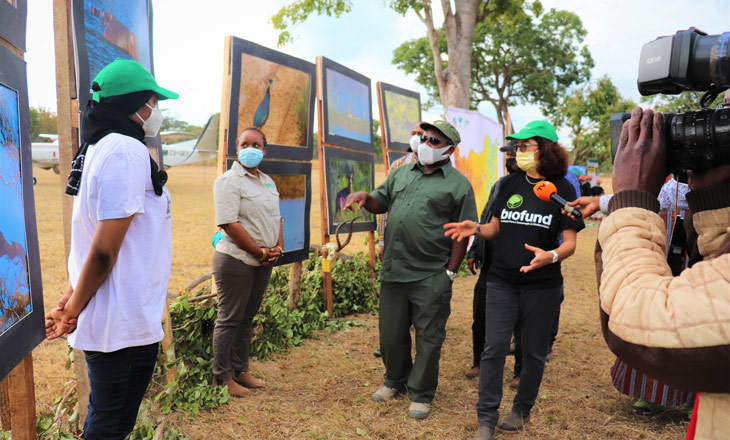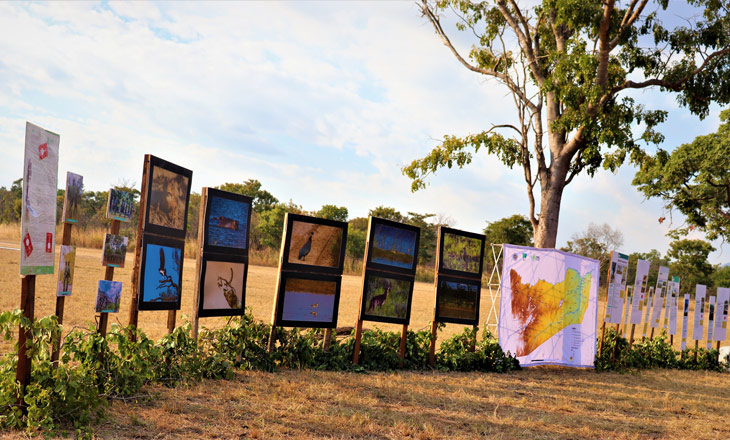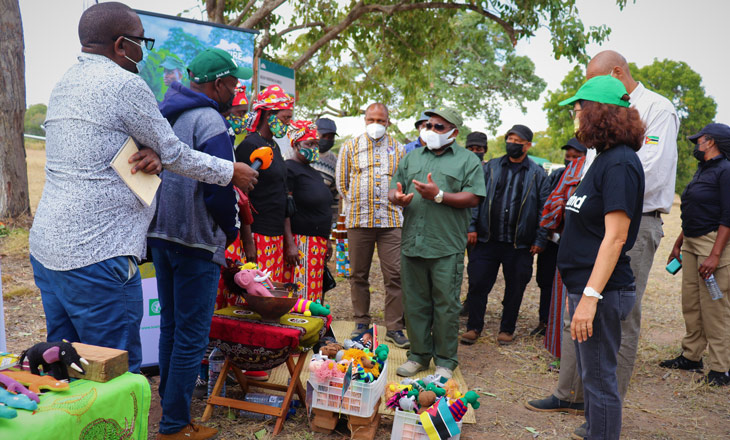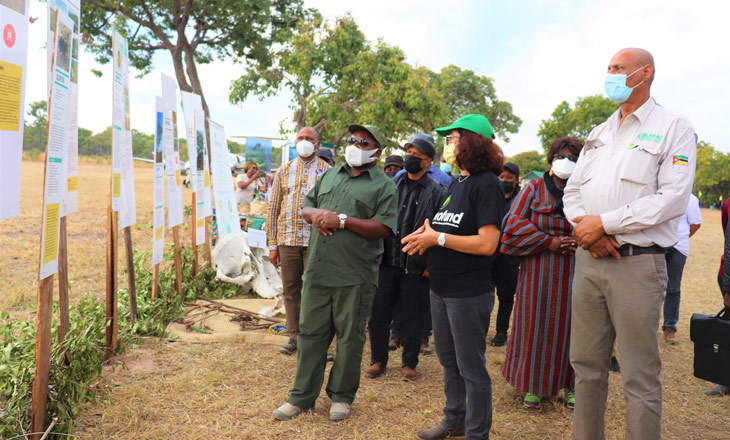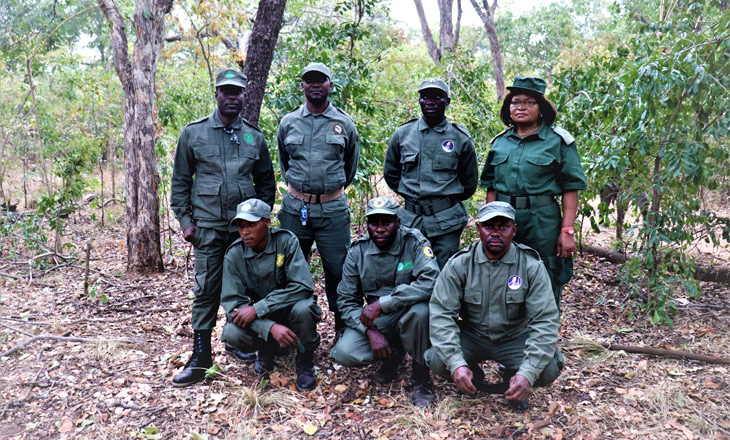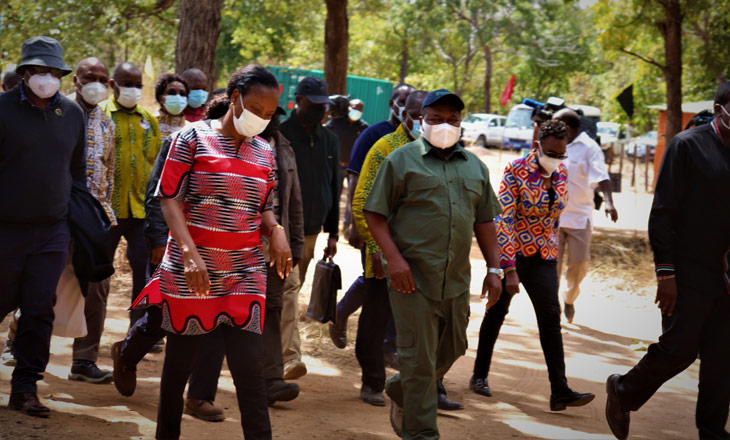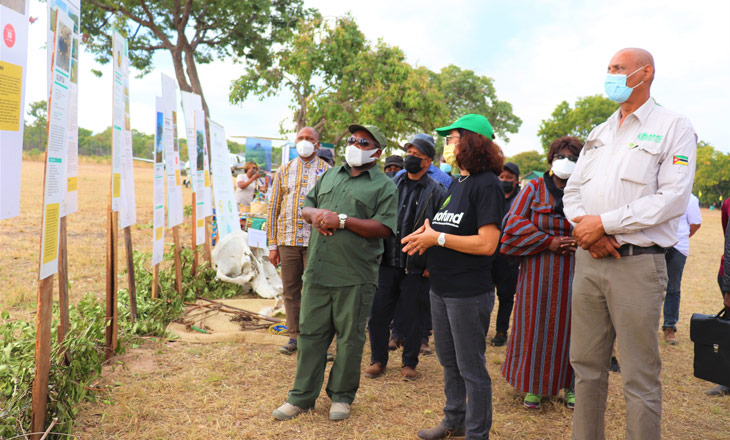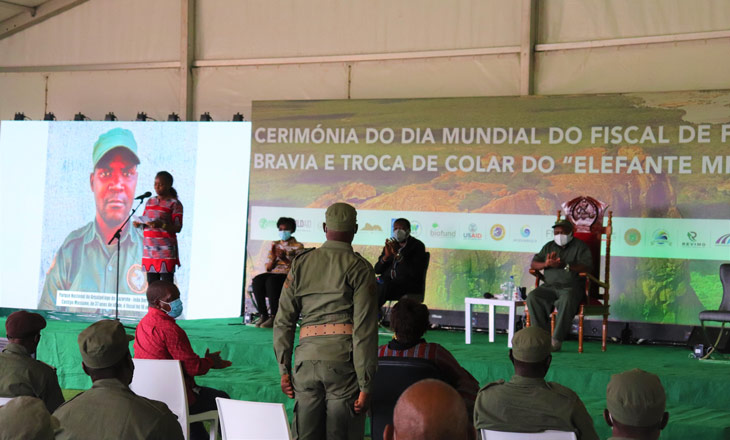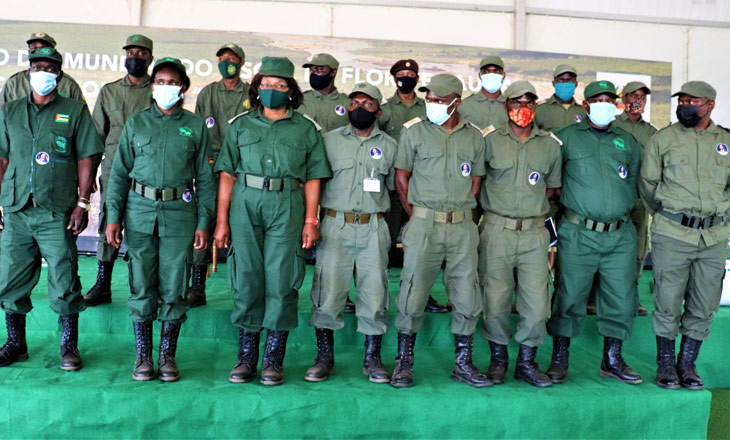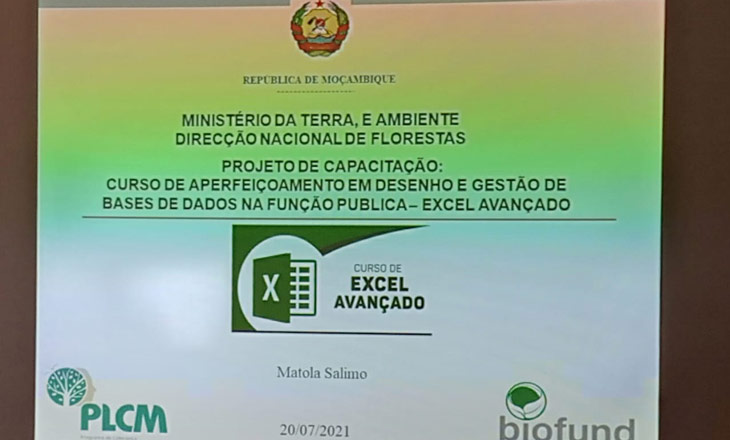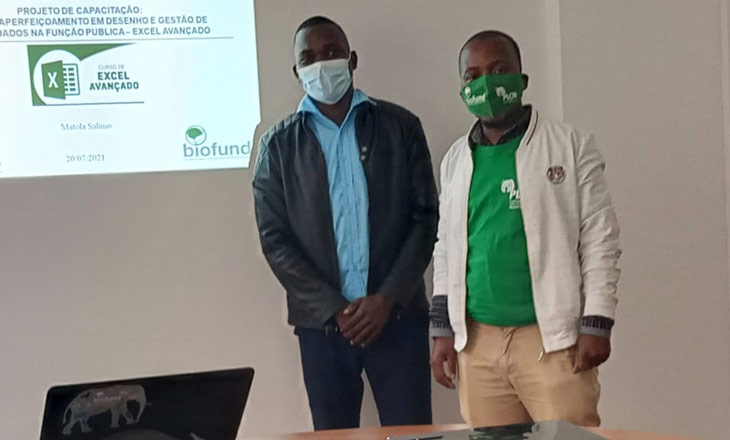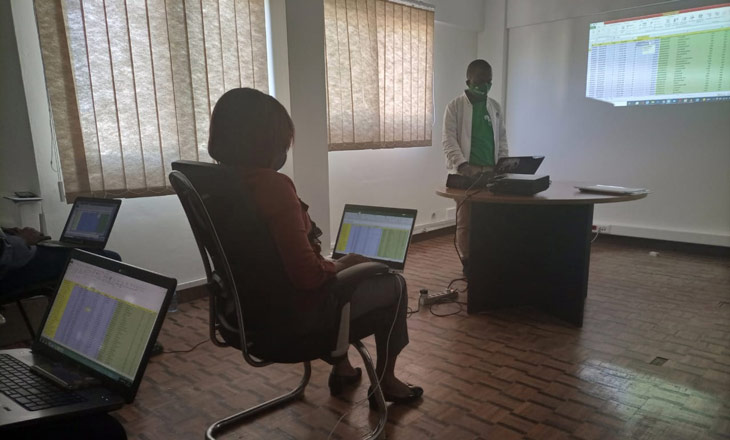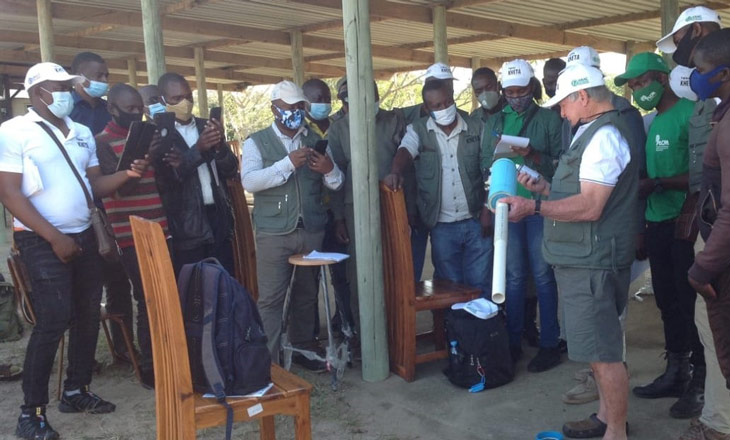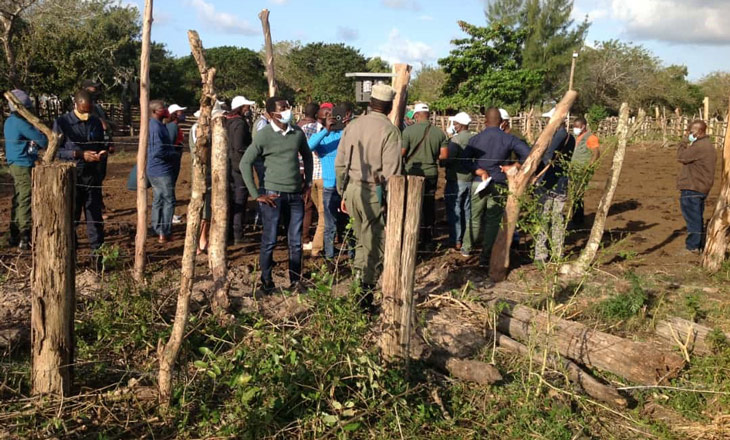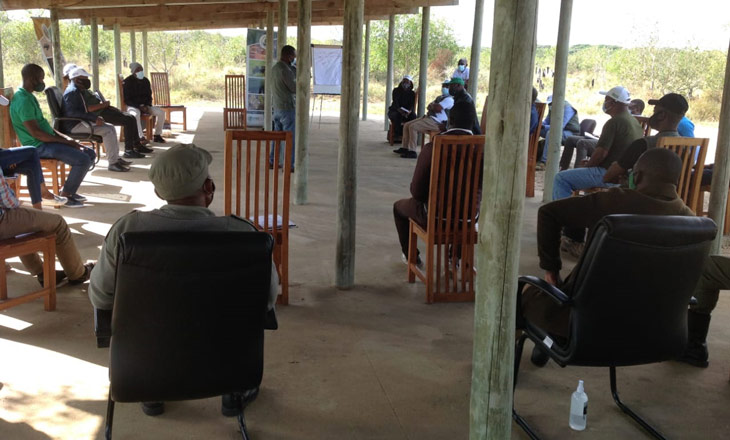This was the third meeting of the Monitoring Group of the Initiatives for the Conservation of Biodiversity in the Licuáti Forestry Reserve and the Surrounding Area, with the purpose to ensure a common vision for the sustainable management of biodiversity and community development in Matutuíne, as well as to coordinate and follow up pilot projects to improve habitats in the Licuáti Forestry Reserve (RFL) and the Maputo Special Reserve (REM).
The Monitoring Group of Initiatives for the Conservation of Biodiversity in the Licuáti Forestry Reserve and the Surrounding Area in Matutuíne assesses the stage of implementation of its activities
The meeting took place in Maputo city (in a hybrid format) on 11 November 2021 and was promoted by the National Forestry Directorate (DINAF) in Coordination with the Foundation for the Conservation of Biodiversity (BIOFUND), the Wildlife Conservation Society (WCS), the National Directorate of the Environment (DINAB) and the National Administration of Conservation Areas (ANAC).
This multi-disciplinary group, consisting of representatives of various government institutions, the private sector, non-governmental and community organisations and academics involved in the conservation of biodiversity and community development in the Landscape of the Elephant Coast, was set up in May 2021 and meets every quarter. There were 39 participants at the last meeting.
During the meeting, an assessment was made of the situation of invasive plant species in the REM and the charcoal value chain in Djabula in the Licuáti region, which are part of the pilot projects for habitat improvement. In addition, lessons were drawn about the start of the Study of the ecological and socio-economic characterisation of the Licuáti Forestry Reserve as a way of creating data bases for future interventions to improve habitats in this landscape.
The Licuáti Forestry Reserve and the Maputo Special Reserve were recently declared as Key Biodiversity Areas (KBAs) at global level and are part of the landscape of the Elephant Coast in Matutuíne, which is a priority area for BIOFUND support.
For more information, access the link https://www.biofund.org.mz/en/projects/biodiversity-offsets-program/
PROMOVE Biodiversidade begins activities of Sustainable Management of the Natural Resources in the First and Second Islands Environmental Protection Area – APAIPS
On 26 November 2021, an implementation partnership agreement was signed between Centro Terra Viva (CTV), the Foundation for the Conservation of Biodiversity (BIOFUND) and the National Administration of Conservation Areas (ANAC), represented by the Minister of Land and Environment, under the Programme PROMOVE Biodiversidade (PROMOVE Biodiversity), to support the First and Second Islands Environmental Protection Area (APAIPS).
This programme is financed by the European Union and implemented by BIOFUND in partnership with ANAC, and seeks to ensure the sustainable management of the natural resources in the APAIPS up to 2025, through disbursing the sum of 3.060.000,00 Euros (three million and sixty thousand euros), to finance activities during these period.
With this intervention, it is intended to implement for the first time sustainable and strategic initiatives to improve the administration and management capacity in the APAIPS, specifically: (a) to improve the protection and preservation of the most critical biological components of the APAIPS; (b) to establish and make operational the infrastructure and resources necessary to guarantee the full functioning of this conservation area; and (c) guarantee ownership by all the interested parties, including the local communities and government at all levels in relation to the goals and function of APAIPS until the conclusion of the project. This support will allow , the establishment of human resources capacity, operational procedures, as well as infrastructures are put into place for the first time allowing the full functioning of this important conservation area, which was created in 2012. This support substantially complements the basic support for operational costs that BIOFUND provides annually from its endowment (originally from the contribution of Conservation International in 2015, for specific long term support for APAIPS).
The activities on the ground will be implemented by the consortium headed by CTV which includes two other institutions, namely TerraNautics (a consultancy company with experience in the design, management and monitoring of conservation projects, both marine and terrestrial, the development of technological applications for the management of protected areas and prevention of crimes against wild life), and Conserve Global (a company whose goal is to safeguard protected areas outside of the national parks, ensuring the sustainable use of natural resources for the subsistence of communities). This consortium was chosen through a public tender, and will begin activities on the ground this year, in close collaboration with the APAIPS administration, as well as with other operational organisations, such as WWF and others.
The PROMOVE Biodiversidade programme also supports the implementation of community development activities, conservation of biodiversity, and dissemination of applied research and participatory studies linked to the management of natural resources on Mount Mabu and in the Gilé National Park.
This programme forms part of a broader, integrated Rural Development programme of the European Union, known as “PROMOVE Global” which consists of 6 (six) specific programmes, namely PROMOVE Agribiz, PROMOVE Biodiversidade, PROMOVE Nutrição, PROMOVE Energia, PROMOVE Comércio and PROMOVE Transporte, all focused on Zambézia and Nampula provinces, and implemented by various organisations.
BIOFUND highlights its role in the conservation of marine and coastal biodiversity in Mozambique, during the 2nd Edition of the International Conference Crescendo Azul
In the second edition of the International Conference Crescendo Azul, which took place in Vilankulo, Inhambane province from 18 to 19 November 2021, the Foundation for the Conservation of Biodiversity – BIOFUND, highlighted the importance of conserving marine and coastal biodiversity, as well as the role of conservation areas in Mozambique in protecting biodiversity and providing ecosystem services.
Speaking at the plenary session on Innovation and Ocean, Alexandra Jorge, Director of Programs at BIOFUND, highlighted that the marine and coastal Conservation Areas are of great importance to maintain the balance of ecosystems, conservation of numerous species of fauna and flora, promotion of tourism and economic development of the surrounding communities.
Alexandra Jorge highlighted that BIOFUND has supported, since 2017, all 7 Conservation Areas of coastal and marine biodiversity in the country, namely the Maputo Special Reserve (REM), Ponta de Ouro Partial Marine Reserve (RMPPO), National Reserve of Pomene (RNP), Bazaruto Archipelago National Park (PNAB), Wild Sanctuary of Vilanculos in Cabo São Sebastião (SBV), Primeiras and Segundas Environmental Protection Area (APAIPS) and Quirimbas National Park (PNQ).
During the session, the representative of BIOFUND highlighted the role and added value of BIOFUND for the conservation of biodiversity in Mozambique, referring to the direct and sustainable long-term support to public and private Conservation Areas in the country, the promotion of new leaders in conservation and also a focal point and fundraising agent for new innovative financing opportunities, highlighting recent opportunities available from the Rain Forest Trust to support new protected areas and from the Global Funds for Coral Reefs. BIOFUND was recently selected to be the convening agent for the GFCR in Mozambique, opening new opportunities for the protection, preservation, and investment in coral reefs in the country and new multi-sector synergies.
Also at the event, BIOFUND led the organization of a side-event on mangroves and marine sustainability in collaboration with the Instituto de Investigacao Pesqueira (IIP) and the International Union for Conservation of Nature (IUCN). This hybrid event brought together around 60 participants and several national and international initiatives on mangrove conservation were presented and discussed, with emphasis on the Metrics to assess the condition of mangroves – a partnership between BIOFUND, UEM and WCS.
In this event of national and international scope, BIOFUND also marked its presence with an exhibition of marine and coastal biodiversity, presented by interns from the Leadership Program for the Conservation of Mozambique (PLCM), who interactively illustrated the main habitats to the public, the marine species existing in the marine and coastal Conservation Areas of Mozambique, as well as introduced the different programs implemented by BIOFUND. The exhibition had around 600 visitors, including the President of the Republic, Filipe Jacinto Nyusi, his counterpart the President of the Republic of Kenya, Uhuru Kenyatta and several foreign delegations, the Minister of the Sea, Inland Waters and Fisheries, Augusta Maíta and other high-level nationals.
Follow here the different moments of this conference organized by the Ministry of the Sea, Inland Waters and Fisheries.
1st winner of the Bio card campaign visits the Maputo Special Reserve
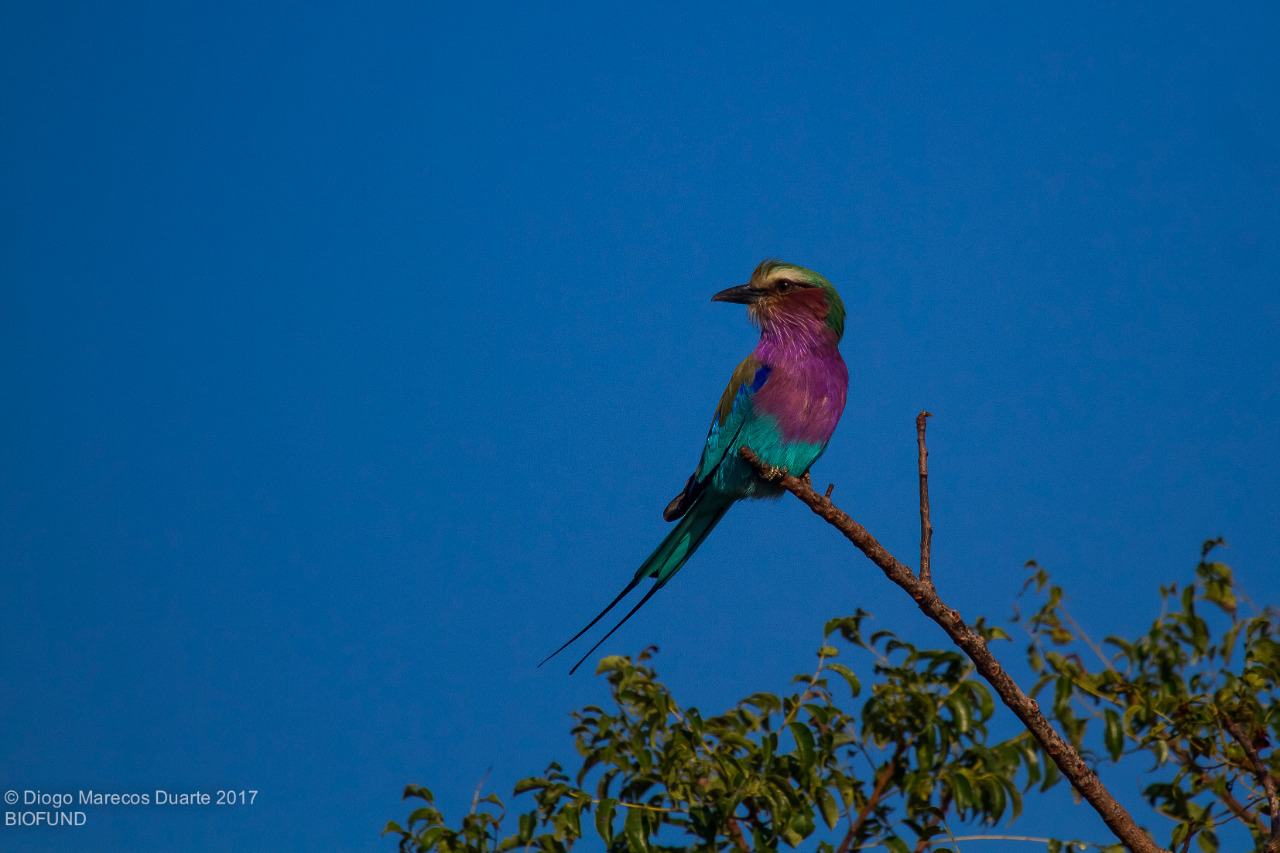
In the Bio card incentive campaign, the Foundation for the Conservation of Biodiversity (BIOFUND), in partnership with the Commercial and Investment Bank (BCI), offered a guided visit to the Maputo Special Reserve to the client who made most transactions with the Bio card.
This is the first visit offered under the campaign, the objective of which is to provide a unique experience with nature to the users of the Bio card. The winning couple, who are from Nampula province, had never had the opportunity to see such a variety of animals before, and they thought the experience was very good.
“We are very happy to be here because of the prize we won, and mainly because through the card we are contributing to the conservation of biodiversity. We have seen animals that we only used to see on television, such as an elephant. We were some 15 or 10 metres from the elephant, and it’s marvellous”, added António Lopes.
The Bio card is the first biodegradable bank card in Mozambique. It was created in 2017, as the result of a partnership between the BCI and BIOFUND. As part of its social responsibility, the BCI channels to BIOFUND a percentage (0.04%) of all the sums transactioned with the card, without additional costs to its users, as well as part of the annual card fee.
There are now more than 23,850 users of the Bio card, and thanks to the funds generated by this card, BIOFUND has already supported the protection of rhinoceros in the Sábiè Game Park and the protection and conservation of a very rare species of a giant palm tree, Raphia australis. It is an endangered species and it is located in the Bobole Botanical Reserve.
Mangroves and Marine Sustainability under debate at the 2nd Edition of the Growing Blue International Conference
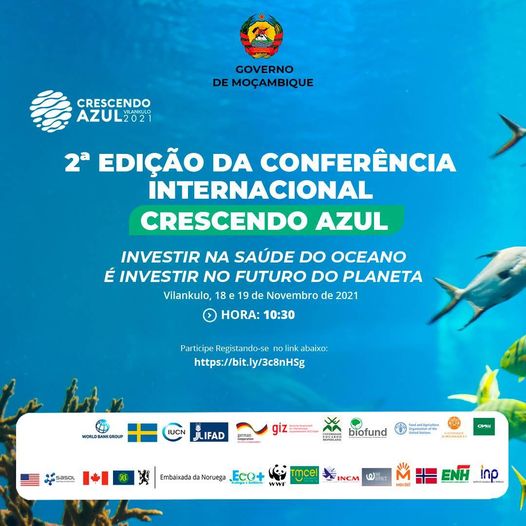
The Ministry of the Sea, Inland Waters and Fisheries, together with its partners, will hold the second edition of the Growing Blue International Conference on 17-18 November, in Vilankulo district, Inhambane province, under the theme “Investing in the health of the ocean is investing in the future of the planet”.
The event will have about 1,000 participants in hybrid format, with 400 of them physically present, and the others attending virtually, including national and foreign researchers, investors and politicians, once again sharing knowledge and consulting in the context of the sustainable development objectives of the blue economy.
The Mangroves and Marine Sustainability is one of the themes being placed under debate during the second edition of the Growing Blue Conference. In order to share information and research undertaken by Mozambican and international specialists, the theme will be debated in a parallel hybrid event, held by the National Institute of Fisheries Research (IIP) in partnership with the IUCN and the Foundation for the Conservation of Biodiversity (BIOFUND), from 8:30 to 11:00 on 19 November at the Nhafudo Hotel in Vilankulo.
At this Conference, BIOFUND will also leave its mark of exhibiting marine and coastal biodiversity through participation in the Growing Blue Exhibition-Fair, in the component of science, technology and innovation which will run during the two days of the event, involving the experience of some of the interns of the Mozambique Conservation Leadership Programme (PLCM) in marine areas, as well as a presentation on the role of environmental funds in the agenda of the oceans and the blue economy. Follow the major moments of this Conference by participating virtually through the link.
More than 400 people reached by the Environmental Education Actions of BIOFUND at the Inhaca Book and Biodiversity Fair
Inhaca was the stage for the Kanyaka Book Fair, an initiative promoted by Maputo Municipal Council and its partners, such as the Maputo Portuguese School, AMOCINE, BIOFUND, ANAC, AMOLP, IMPACTO and the Inhaca Maritime Biology Station. The Fair was held between 6 and 8 November 2021, under the theme “The history of the future is written on the Island” seeking to promote the relationship between literature and environmental education.
To mark the opening of the fair, the Mayor of Maputo, Eneas Comiche, inaugurated the Inhaca municipal library at the Inhaca Noge Complete Primary School. He stressed the importance of the fair and of the library for the residents of Inhaca. “I feel honoured to initiate the Inhaca Book and Biodiversity Fair. Books sustain the scientific knowledge acquired in school, and the choice of the theme ‘Literature and Biodiversity’ draws attention to the most attractive areas of Inhaca island, which we have to protect”, stressed Eneas Comiche. Participating in the event were the writers Ungulani Ba Ka Khosa, Teresa Noronha, Álvaro Fausto Taruma (who was born on Inhaca), Aciena Manave, Juvenal Bucuane, Silvia Macie and Dionisío Manhiça.
The intersection between literature and the conservation of biodiversity is an unequalled opportunity to make society aware of the importance of the conservation of biodiversity. BIOFUND took part in the event and raised the awareness of more than 400 people, focusing particularly on children of between 6 and 15 years of age, through various activities of environmental education, such as the Biodiversity Exhibition and a lecture and play about the importance of conserving the mangrove forest, improvised with pupils aged between 9 and 12, which will remain in the memory of the residents of Inhaca. Also on this occasion, BIOFUND donated 10 information panels about marine species and habitats, to be used by the Inhaca Maritime Biology Station in its environmental education activities.
Also during this visit, synergies were explored with the Maputo Municipal Council as well as the Inhaca Maritime Biology Station to continue the environmental education programme, including the production of content, making materials available, sharing information, and training the children and young people of Inhaca Island, which is an integral part of the Ponta do Ouro Partial Marine Reserve. The Reserve is a beneficiary of BIOFUND.
Since 2015, BIOFUND has undertaken activities to publicise the importance and relevance of our biodiversity, through an annual biodiversity exhibition held in various provinces, mainly involving a young public and local schools, mostly at provincial level, through a variety of audio-visual materials. The Inhaca Book and Biodiversity Fair has boosted BIOFUND’s environmental education actions, reaching a more remote public, at district level, and also motivating teachers to take up environmental themes. It also brings information about the main threats to our biodiversity and, above all, how to preserve it.
BIOFUND participates in 1st Edition of the Quelimane Youth Fair in Zambézia province
Under the motto “Nourish the Future: undertake and innovate for sustainable production” the 1st edition of the Quelimane Youth Fair, was held in the city of Quelimane. This event was organised by the French Embassy in Mozambique and the Licungo University, with funding from the European Union. Participating in the fair were the Foundation for the Conservation of Biodiversity (BIOFUND) and other partners.
This forum is an initiative to create business opportunities, in which 50 young people from Zambezia province presented their income-generating projects in the areas of agriculture, aquaculture, livestock and food processing. During the fair, the five (5) best innovative projects were selected. Out of these, the 3 winners will benefit from technical and financial support to be provided by the French Embassy during one (1) year for the implementation of their projects in a sustainable manner, empowering new jobs and the entrepreneurial spirit. BIOFUND took part as a member of the Jury that assessed the project proposals and contributed to the selection of the 5 winning candidates, including 2 girls.
The opening session of the Forum was addressed by H.E. the Secretary of State for Zambezia Province, the Ambassador of the European Union in Mozambique, the Counsellor for Cooperation and Culture at the French Embassy in Mozambique, the Vice-Chancellor of the Licungo University and the Mayor of the City of Quelimane. In their speeches, these personalities stressed the relevance of young people in the development of the country. With encouraging words, they invited all youths, particularly girls, to take advantage of this learning and transformation experience for a better future.
During the 3 days of the Forum, the participants were able to attend intensive workshops on the themes of creation of business plans, facilitated by a representative of GAPI, drawing up commercial studies facilitated by the representative of AQUAPESCA, negotiation techniques facilitated by the bank Societé Generale Moçambique and Assessment of the Social and Environmental Impacts in the development of projects with facilitation by BIOFUND.
Over the 3 days of training, BIOFUND, represented by the technical team of the Project “PROMOVE Biodiversidade” (Promote Biodiversity) and by the Biodiversity Offsets Programme, led various sessions on the relevance of biodiversity in promoting the economic development of the country, and publicised the various training opportunities provided by its programmes, focused on the Biodiversity Conservation Leadership Programme (PLCM) and PROMOVE Biodiversidade, which are relevant for young people and for Zambézia province.
BIOFUND’s participation in this initiative restates our mission of promoting the conservation of biodiversity in Mozambique through publicising application of the mitigation hierarchy in project development, sharing opportunities for training Mozambican youths, and crating new partnerships nationally.
PROMOVE Biodiversidade Programme, in Partnership with FFS-IGF, Strengthens Community Development in Gilé National Park
To this end, six Community Health Councils of Gilé National Park received support materials in October to improve their activities with local communities.
The list of materials included 18 bicycles, mobile phones, complete kits for nutrition groups, monitoring sheets, and school bags. Awareness-raising materials against uncontrolled bushfires were also delivered, with the expectation that they will contribute to changing the behavior of local communities.
The delivery of materials was carried out by the Administrator of Gilé National Park, in the presence of the Director of the District Service of Health, Women and Social Affairs and the Permanent Secretary of the Pebane District, in the communities of Musseia (Pebane District), Namahipe, Sacane, Luanula, Naheche, and Malema Centro (Gilé District).
During his remarks, the Permanent Secretary of Pebane District praised the support and commitment of Gilé National Park, drawing the communities’ attention to making good use of the materials, since the Government’s goal is to ensure communities have greater access to information to better protect themselves.
This initiative is part of the partnership between the park and the District Health Services of Pebane and Gilé for the implementation of the Community Health Program in Gilé National Park. Its main objective is to strengthen, train, and equip Community Health Committees to ensure that communities have access to basic information on reproductive rights, nutrition, maternal and child health, gender-based violence, COVID-19, and other relevant topics in the local context.
The Community Health Program of Gilé National Park has 4,000 beneficiaries who will continue to receive support in the coming years, under the PROMOVE Biodiversidade Programme, funded by the European Union and implemented by BIOFUND. One of its objectives is to finance biodiversity conservation and community development in Gilé National Park, Mount Mabu, and the Environmental Protection Area of the Primeiras and Segundas Islands (APAIPS).
BIOFUND and ANAC train key actors on Mount Mabu about the Management Effectiveness Tracking Tool for Conservation Areas
This is the first capacity building exercise undertaken by the Foundation for the Conservation of Biodiversity (BIOFUND) and the National Administration of Conservation Areas (ANAC), in the framework of implementing the PROMOVE Biodiversidade (Promote Biodiversity) project, which seeks to support the Conservation of Biodiversity and Community Development on Mount Mabu.
The training occurred on 12-13 October 2021, in the city of Mocuba, Zambézia province. 20 trainees took part, including the Director of the Lugela District Economic Activities Service, the Director of the Lugela District Planning and Infrastructure Services, the Head of the Tacuane Administrative Post, the Head of the Muabanama Administrative Post, the Head of Mabu Locality, the head of Mpemula locality, leaders of five local communities and a representative of the local private sector.
The training sought to establish a base line of the Effectiveness of Management for Mount Mabu, using the METT tool (Protected Area Management Effectiveness Tracking Tool), involving the identification and involvement of the affected and interested key areas on Mount Mabu and their management, training in how to use the METT tool, and a practical exercise in evaluating the tool for Mount Mabu through a participatory process, involving all the key stakeholders of the area.
The METT tool consists of a simple approach, through a questionnaire that includes scoring and an assessment form on the degree of risk posed by the threats to the Conservation Area, in order to provide mechanisms to monitor and report the effectiveness of management over time. This will allow the Administration of the Conservation Area, donors and partners to identify needs, constraints and priority actions for the management of the Conservation Area. This tool was developed for the first time in 1998 by the Alliance between the World Bank and WWF, for the Conservation and Sustainable Use of Forests.
Mount Mabu is an area rich in biological diversity, located in Lugela district, Zambezia province. It is one of the three beneficiaries of PROMOVE Biodiversidade, which is being implemented by the consortium formed by WWF, R-GCRN and RADEZA and is financed by BIOFUND through funds from the European Union
Visit the BIOFUND web page and remain up-to-date with the activities developed under the PROMOVE Biodiversidade programme in Zambézia and Nampula provinces.
Invasive plant species under study in the Maputo Special Reserve
This study is being undertaken by the Foundation for the Conservation of Biodiversity (BIOFUND) in the framework of the Biodiversity Offset Programme, implemented with the financial support of the World Bank/MozBio2 Project and UNDP/BIOSFAC in partnership with the Wildlife Conservation Society (WCS), the National Environment Directorate (DINAB) and the National Directorate of Forests (DINAF).
The study seeks to provide information about the density of invasive plants, the areas occupied by invasive plants, the priority areas for restoration within the Maputo Special Reserve (REM) and the development of a plan for restoring and rehabilitating habitats for the reserve.
A technical team, between 5 and 14 September 2021, held a field survey on invasive plants in the REM, during which 16 invasive species were identified. The most common invasive species in the REM include Lantana camara, Psidium guavana, Chromalaena odorata and Eucalyptus sp. The Eucalyptus covers an estimated area of 800 hectares within the REM.
Invasive species are exotic plants which spread without control. They pose a threat to native species and to the balance of ecosystems, and may even pose a risk to people.
The study is being carried out by Colterra Environmental Consultants, a consultancy company hired by BIOFUND, under the pilot project on improving habitats for the REM. In addition to the Maputo Special Reserve, the Licuáti Forest Reserve (RFL) is also one of the areas covered by these projects which are seeking to test the technical and financial viability of biodiversity offsets in Conservation Areas and Forest Reserves in Mozambique.
For further information on this and other activities undertaken by the Biodiversity Offsets programme, click here.
European Union disburses 750,000 Euros to strengthen the BIO-Emergency Fund
The European Union recently signed a financing agreement with the Foundation for the Conservation of Biodiversity (BIOFUND) to strengthen the BIO-Emergency Fund, in order to increase the fund’s coverage. The Fund is intend to preserve the jobs of the rangers and other staff who are fundamental for supporting inspection in the Conservation Areas, to mitigate the effects of the Covid-19 pandemic.
This is financing of about 750,000 Euros (approximately 14 million meticais) which will be channelled to Conservation Areas under public and private management, including areas of community management. With this support, it will be possible to cover the full payment of wages for the rangers and essential support staff in the Conservation Areas, as well the payment of costs directly linked to inspection and patrolling activities, which were previously covered by revenue from tourism. This support also includes preventive material against Covid-19.
With the BIO-Emergency Fund, more than a thousand rangers, are still at their posts. Currently 26 Conservation Areas (ACs) are benefiting from this fund. !3 of these ACs are under private management, 11 are under public management, and two are community ACs, which are benefiting more than 600 families. More than 13,139,211 hectares of biodiversity have been protected since the creation of the Fund. This is 63% of the total protected area in the country. It is hoped that with this increase in the capital of the BIO-Emergency Fund, by December 2021 the wages of more than 600 rangers, including essential support staff in the ACs, will be guaranteed. This will make more than 20,000 patrols possible.
This emergency fund was launched in June 2020, initially designed for a period of one year. However, due to the evolution of the Covid-19 pandemic in the country, which is continuing to damage the tourism sector, the Board of Directors of BIOFUND approved extending the period of coverage of the fund by a further six months, up until December 2021. It has been possible to implement this, thanks to this boost to the budget. BIOFUND is also the manager of the PROMOVE Biodiversidade project, which has been financed by the European Union since 2019. This supports substantially the conservation of biodiversity in the Gilé National Park, in the First and Second Islands Environmental Protection Area, and on Mount Mabu.
The Mozambican biodiversity conservation community mourns the tragic murder of marine biologist Lara Muaves.
It is with great sadness that the Foundation for the Conservation of Biodiversity (BIOFUND) received the news of the tragic death of marine biologist and conservationist Lara Cristina Muaves, senior staff at the World Fund for Nature in Mozambique (WWF), on 14 October 2021, in Maputo.
In her lifetime, Lara made a remarkable contribution to marine conservation. BIOFUND had the pleasure to work with her in 2020 on the pre-launch of the Conservation Leadership Program for Mozambique (PLCM), in an online event with more than 400 young people – with Lara leading a webinar on “Leadership Opportunities and Challenges for Young People in the Conservation sector”.
In this webinar Lara shared her passion for biodiversity conservation, shared her life experience and inspired several young Mozambicans to choose this area as a professional career.
“To be a conservationist is to exceed your expectations every day, it is to be persevering and humble”. – said Lara Muaves.
BIOFUND extends its condolences to her family, friends and colleagues at WWF for this irreparable loss.
BIOFUND, WCS and DINAB promote Intensive Training on the application of the Mitigation Hierarchy in Mozambique for Government technicians
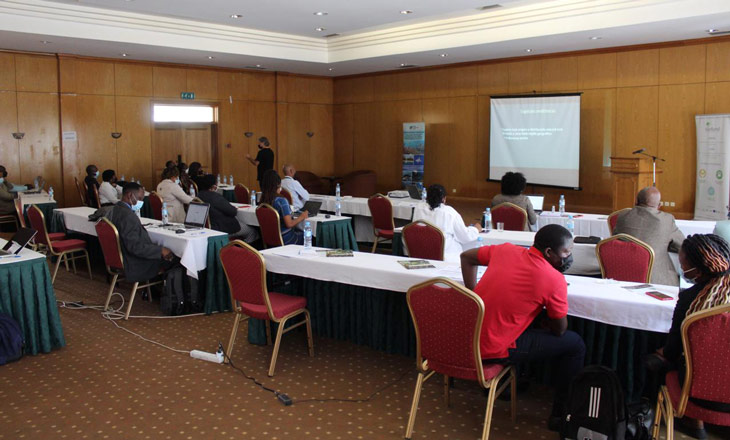
Foundation for the Conservation of Biodiversity (BIOFUND) in partnership with the Wildlife Conservation Society (WCS) through the COMBO+ Project and the Ministry of Land and Environment (MTA) represented by the National Directorate of Environment (DINAB) with financial support from World Bank/MozBio2 Project and UNDP/BIOSFAC, conducted between the 12th and 13th of October 2021 the first module of the intensive training program for 25 technicians from various sectors of MTA on the application of the mitigation hierarchy in Mozambique.
This module provided by IMPACTO’s environmental impact assessment specialists focused on the Basic Fundaments for the application of the Mitigation Hierarchy, including Biodiversity Offsets in Mozambique and included the review of the environmental impact assessment legal framework, key principles for planning and assessment of biodiversity condition in environmental impact studies and brief introduction to the concept of the mitigation hierarchy.
During the training, trainees and trainers had an open dialogue about the various topics presented, as well as practical measures for implementing the mitigation hierarchy, using as example the various ongoing development projects in the country.
This intensive training program for technicians from the DINAB Biodiversity Offsets Department and other sectors of the MTA on the implementation of the mitigation hierarchy and biodiversity offsets, comprises 6 modules and will be delivered until March 2022.
BIOFUND and WCS have carried out trainings for technicians from the Government, civil society, private sector and academia since 2016 and has more than 1000 technicians trained in area of implementation of the mitigation hierarchy and biodiversity offsets at national level.
For more information about the Biodiversity Offset Program click here
BIOFUND elected member of Executive Committee of the Consortium of African Funds for the Environment
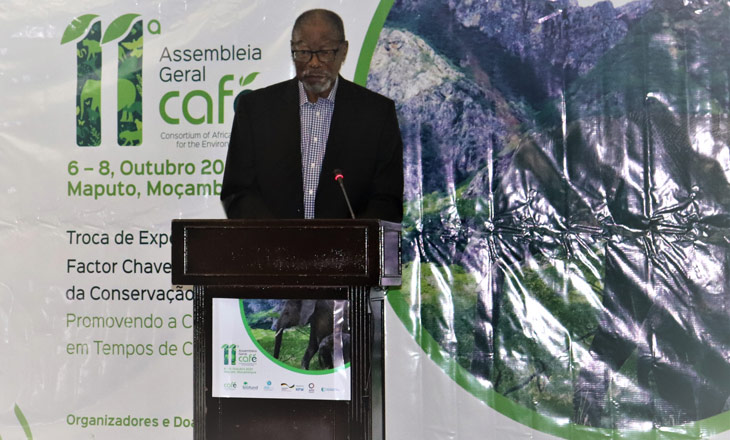
The Foundation for the Conservation of Biodiversity (BIOFUND), became a member of the Executive Committee of the Consortium of African Funds for the Environment (CAFÉ), in the person of its Executive Director, Luís Bernardo Honwana.
Also elected to this committee were the executive directors of the environmental funds Fondation Tri-National Sangha, Fondation Parcs et Reserves de Cote D´Ivoire and the Okapi Fund for Nature Conservation in the DRC. The environmental funds Community Conservation Fund of Namibia, Uganda Biodiversity Fund and Fondation des Savanes Ouest Africaines were already members of the Executive Committee.
The decision was taken through a vote of the 14 environmental funds, who are members of CAFÉ, and who were present at the 11th General Assembly. This meeting took place from 6 to 8 October 2021, in Maputo City, in a physical and virtual form.
The Executive Committee of CAFÉ is responsible for taking decisions on access to sustainable funding for the sector in Africa, and it consists of 7 members. Through the inclusion of BIOFUND in this Committee, Mozambique is, for the first time, becoming an important actor in the creation of policies of sustainable financing for the conservation of biodiversity in Africa. This fact is added value for the sustainable development of the CAFÉ member countries.
During this meeting, the Kenya Environmental Fund NETFUND was accepted as a member of CAFÉ. This brings to 19 the number of Conservation Trust Fund members of this continental collaborative network.
During his speech at his election, the Executive Director of BIOFUND, Luís Bernardo Honwana, expressed his satisfaction at become a member of the body that looks after the better functioning of the funds which contribute to the adoption of innovative policies and financial mechanisms to promote the conservation of biodiversity and sustainable development in Africa. – “We are the main interlocutors in economic development and in the conservation of biodiversity. Each of us should take a position that guarantees achieving the desired results in Africa”.
The 11th General Assembly of CAFÉ also discussed the transitional presidency of the body for next year, 2022, in order to strengthen the governance and leadership of CAFÉ, as well as sharing the reports and plan of activities of each Conservation Trust Fund member.
For more information about CAFÉ and its activities, see https://www.cafeconsortium.org/
32 countries participate in the 11th General Assembly of the Consortium of African Funds for the Environment
From 6-8 October 2021, Mozambique hosted in Maputo, in hybrid format (part physical presence and part virtual) the 11th General Assembly of the Consortium of African Funds for the Environment (CAFÉ). Participating in the event were 32 countries from four continents – 16 countries from Africa, six from America, nine from Europe and one from Asia. The meeting was financed by German cooperation, through KfW, and by FFEM.
The opening ceremony was chaired by the Mozambican Minister of Land and Environment, Ivete Maibaze, who stressed the preponderant role that CAFÉ has played in commitment for conservation in Africa, since it was set up in 2011.
In his opening speech, the President of the Board of Directors of the Foundation for the Conservation of Biodiversity (BIOFUND), which organised the conference, stressed that the environmental funds supplement the funds from the Government, ensuring the sustainability of specific activities in the Conservation Areas. They also attract new sources of finance for conservation in the country.
The three days of the conference were marked by a series of presentations given by 59 speakers, notably the members of CAFÉ and national and international conservation partners who shared motivating experiences about their performance in the conservation sector, the operation of environmental funds, and about access to financing opportunities, among other themes.
During the first day of the conference, ten members of CAFÉ presented their progress, challenges and opportunities since the last General Assembly of CAFÉ, held in 2019, in Benin. In this first session, there were inspiring presentations about conservation work in the Gorongosa National Park, and in the Bazaruto Archipelago National Park among others.
On the second day, the funds stressed the need to improve coordination at national and regional level and the diversification of mechanisms of financing to ensure effective support for the conservation of biodiversity, in thematic discussions held in parallel sessions that ran to the end of the day.
On the third day of the event, Jorge Ferrão, the Vice-Chancellor of the Pedagogic University stressed the role of the development of the academic world through the training of new leaders and researchers, capable of working for the conservation of biodiversity in Mozambique and throughout the world
Final considerations at the meeting were given by Carlos Manuel Rodriguez the CEO of the Global Environmental Fund (GEF) who shared a realistic perspective on the role of Conservation Trust Funds (CTFs) in supporting the conservation of biodiversity and the global agenda for the environment, stressing the relevance of governments having consistent and coherent policies as well as the need to mobilise resources more efficiently. “In 25 years of work in conservation, I have never seen a strong tool such as the CTFs, as true complementary partners for an effective conservation of biodiversity” – Carlos Manuel Rodriguez.
Participants at this meeting also discussed specific matters about the functioning of CAFÉ. The 11th formal session of the General Assembly of CAFÉ was held in virtual format on the last day of the event, with the participation of the executive directors of all the environmental funds present.
For the first time, the CAFÉ Assembly could also count on an absorbing Virtual Photographic Exhibition, produced by BIOFUND with images provided by collaborators, partners and friends of conservation. This exhibition is still available to be visited through the link https://tinyurl.com/BIOFUNDvirtualexhibition
This conference had a large national and international reach. 601 people attended on the first day, 236 on the second day, and 231 on the third day, giving a total participation of 1,068. For further information on the 11th assembly of CAFÉ 2021, see: https://www.biofund.org.mz/projects/11a-assembleia-geral-do-cafe/
Mozambique hosts the General Assembly of the Consortium of African Funds for the Environment for the first time
The 11th General Assembly of the Consortium of African Funds for the Environment (CAFÉ) takes place in Maputo city, from October 6th to 8th, 2021, at Radisson Blu Hotel at 10h00 am (Mozambique Time), in hybrid format (presential and remotely) with the objective of sharing knowledge and experience to discuss conservation funding mechanisms and opportunities in Africa.
The opening ceremony will be done by the Minister of Land and Environment, Ivete Maibaze, under the topic “Experience Exchange as a Key-factor for the success of Biodiversity Conservation: Promoting Conservation during Crisis Time in Africa.” The conference will have 200 participants of about 30 countries, whereby 15 are African countries, in online and presential format.
The CAFE is the Consortium of African Funds for Environment or Conservation Trust Funds (CTFs) in Africa, created in 2011 where The Foundation for Conservation of Biodiversity (BIOFUND) is one of the founding members, together with over 20 African Environmental Funds. Jointly, CAFÉ fund members manage over USD 300 M invested for a long-term investment capital (endowment fund), as well as tens of USD millions a year from different donors, enabling a massive contribution for African biodiversity conservation initiatives.
The Consortium of CAFÉ is engaged in building a learning community that can share best practices and identify innovative funding mechanisms to promote biodiversity conservation and a sustainable development in Africa.
This event is being financially supported by German Cooperation via KfW and by AFD/FFEM.
Gilé National Park strengthens Beekeeping for the Development of Local Communities
Between 11 August and 8 September 2021, the Community Development Department of the Gile National Park held activities to assess the current stage of implementing beekeeping for the benefit of the local communities.
The practice of beekeeping is part of a series of activities to raise community awareness that the Gile National Park has been undertaking with the aim of promoting the sustainable use of natural resources and community development. In addition to these activities, there also stand out the fight against uncontrolled bush fires and forest degradation, the mitigation of conflicts between people and wild life, and the use of non-timber forest products.
In this context, interviews with the beneficiaries were held, listening to their knowledge about the importance of beekeeping, safety in the exploitation of honey, the techniques used in producing, collecting and managing honey, as well as other derivatives. In addition to the interviews, the beekeepers were accompanied in their workplace, and the techniques and methods used in the entire process of extracting honey were observed.
This activity resulted in harvesting 24,610 litres of honey, in 12 beneficiary communities of the Gilé National Park, namely: Ratata, Munhado, Mihecue, Naheche, Vassele, Namurua, Nacurugo, Muicune, Mucucune, Pipine, Nipamo and Musseia. The honey harvested will be sold, and the money obtained will be reinvested to the benefit of the producer communities so that they may acquire other basic products for their subsistence.
Beekeeping is one of the community activities which it is intended to relaunch and expand with funds from the PROMOVE Biodiversidade program, seeking to create alternative livelihoods for communities living inside and outside the Gilé National Park, which is one of 3 areas benefitting from the Programme financed by the European Union, and implemented by the Foundation for the Conservation of Biodiversity (BIOFUND), in partnership with the National Administration of Conservation Areas (ANAC).
Mágoè National Park has one more vehicle for the inspection of biodiversity
Under the BIO-Emergency Fund programme, the Mágoè National Park received, on 1 September 2021, on the premises of the Foundation for the Conservation of Biodiversity – BIOFUND, a vehicle to assist in the activities to inspect biodiversity.
The BIOFUND Director of Administration and Finance, Celeste Chitará, delivered the new vehicle to the Administrator of the Mágoè National Park, Luis Namanha. The vehicle is intended to strengthen inspection activities, and allow implementation of the Park’s management programmes, in addition to undertaking activities of a social nature. It will facilitate the mobility if the rangers in assisting the vulnerable population, and will reduce the unsustainable use of natural resources, and incidents of poaching which have been on the rise during the Covid-19 pandemic.
For the Administrator of the Mágoè National Park, Luís Namanha, the vehicle represents the appearance of a new son to protect and inspect the Mágoè National Park, since the vehicles the Park already possesses are in no condition to operate properly, particularly at a time when the Park is facing an invasion of illegal loggers.
On the other hand, BIOFUND expects that, faced with this new capacity for inspection, the Park will increase its number of patrols by at least 50%, improve the results of seizures, and reduce the number of animals killed by poachers.
Through the BIO-Emergency Fund, BIOFUND has supported the Conservation Areas in operational costs and in the payment of rangers’ wages, in this period of the pandemic. The acquisition of a vehicle for the Mágoè National Park is the first support from the BIO-Emergency Fund in mobile resources for the inspection of Biodiversity.
PLCM interns acquire experience in Forestry Inventory in Zambézia province
Interns of the Mozambique Conservation Leadership Programme (PLCM), allocated to the National Forestry Directorate (DINAF), have been undertaking, since 15 August 2021, the integrated Forestry Inventory of Forestry Compartments (CF) in Forestry Management Units (UMF) in Mocuba and Lugela districts, Zambézia province, during 4 weeks.
The information gathered on the ground should reflect the current and potential use of forestry resources, including use by the forestry managers, and by the local communities in the area of the UMF in order to reduce the conflicts resulting from the illegal extraction of forestry products and to promote economic viability in forestry production, as well as information that deals with the multiple functions and use of the forests designated for agricultural production.
For the participants in the inventory, Aílton Mungueleze, Baptista Milione, Jonas Vilanculos and Raimundo Manuel, interns trained in Forestry Engineering by the Higher Polytechnic Institute of Gaza, the activity is of great importance for the Forestry Management Units, since the inventory will contribute towards the supply of specific data on the real conditions of the forests, for better management of the natural resources.
This activity is part of the PLCM general plan of internships (with a total duration of six months), which promotes interchange of the interns in various areas of activity in order to acquire a variety of experiences in the sector of the conservation of biodiversity.
Ranger of the year 2021 - José António Amino: a ranger par excellence
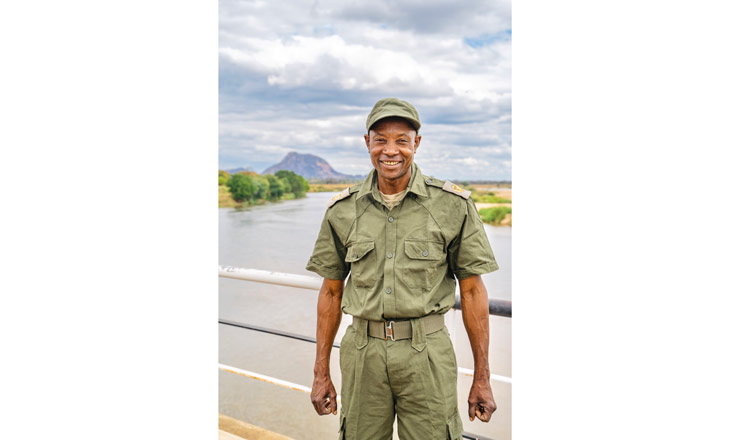
José Amino is a ranger from block L7 of the Niassa Special Reserve, Luwire – Lugenda Wildlife Reserve, and is outstanding for capturing poachers, and seizing a variety of traps used by the poachers.
51 year old José has dedicated himself to the inspection of biodiversity for 15 years. During that period, he has demonstrated his commitment and courage, focusing on the fight against poaching and the protection of wild life. Like the other rangers who are heroes of biodiversity, José Amino has suffered death threats due to his involvement in the fight against poaching and the illegal trade in wild life.
Despite so many challenges, José remains firm in continuing the fight for justice, and putting an end to illegal activities that damage the environment. This ranger is regarded as a reference point because of his professionalism, dedication and commitment.
The Dr. Carlos Lopes Pereira Fund, also known as the Rangers’ Support Fund, is a permanent mechanism for recognising the bravery and dedication of the rangers of the public and private Conservation Areas, through annual prizes which, in this first edition, gave awards to 5 (five) rangers of the public and private conservation areas.
PLCM interns take part in the moving rescue of a lion in game reserve 11
Pride and a sense of mission accomplished characterised the young interns who took part, for the first time, in a mission to rescue an animal. It was not just any animal – we are talking about the king of the jungle, who fell into a trap laid by poachers.
Coincidence or not, this occurred on 10 August, World Lion Day, in one of the areas being restocked with lions, in game reserve 11.
The lion was injured in one of its paws, which made it impossible for it to move for about 3 (three) days. It was only located because it carried a control chip, placed in 2020, que facilitates following and protecting the lion. According to Willem Briers- Louw, the conservation manager in the game reserve, and supervisor of the PLCM interns, when they realised that the lion had been in the same place for days, they wasted no time and went to the place.
Removing the snare took about 40 minutes after the lion had been duly sedated. After the removal of the snare, the lion was medicated with serum, and the wound was disinfected, since it had almost lost one of its paws. And since it was impossible for him to move, the king of the jungle had the right to a “buffet service”, so that he could feed without the need to go hunting, while he was recovering.
For the three interns, Menáice Zunguze, Wiliamo Daniel and Mateus José, participating in this operation was an unprecedented experience. It was a true privilege to be able to assist the guardian of the jungle.
Remain attentive to our social media, and find out more about the various activities to conserve biodiversity.
Ranger of the year 2021-Talento Luwemba: Young leader and hero of biodiversity
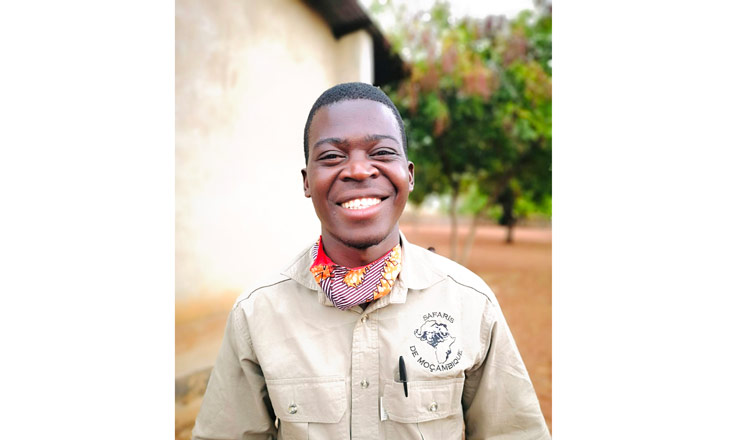
Talento Luwenda stands out because of his leadership in the fight against poaching. He is a 28 year old young man, who is a ranger in the Tchuma Tchato programme in Safaris de Moçambique. He has been working as a ranger for 5 years.
According to his superiors, Talento always showed an interest in working for the conservation of biodiversity, and has brought excellent results from his work with the communities. Thanks to his determination and his leadership spirit, he has been head of the rangers since 2019.
The outstanding activity which contributed to his nomination as one of the Rangers of the Year 2021 by the Dr. Carlos Lopes Pereira Fund was his leadership in the fight against poaching which culminated in the detention of famous hunters of leopards and elephants. During these activities, Talento suffered serious injuries which put his life in danger. Despite these events, his determination remains unshaken.
His colleagues view Talento as a young leader who inspires others through his courage and commitment, since he does not hesitate to put his own life at risk in order to protect biodiversity.
Gorongosa National Park receives PLCM interns
Two interns from the Mozambique Conservation Leadership Programme PLCM) have been taking part in Environmental Education activities since 15 August in Gorongosa National Park.
The environmental education activities are being undertaken within the communities in the buffer zone of the Gorongosa National Park, and they include lectures, games, music and showing films on themes related to the conservation of biodiversity.
With these activities, PLCM interns Silvia Durão and Davane Manjate, stationed at the Directorate of Conservation and Community Development Services/Environmental Education in the National Administration of Conservation Areas (ANAC), are understanding in practice how to maintain an active and dynamic club, as well as how to manage natural resources in the park, and how to identify the challenges of team work.
Their stay extends to 13 September, and includes interaction with the Natural Resource Management Committees of the Gorongosa National Park and of the buffer zone.
Ranger of the year 2021- António Soze Fombe: “To be a ranger is to give one’s life for the good of conservation without expecting immediate results”
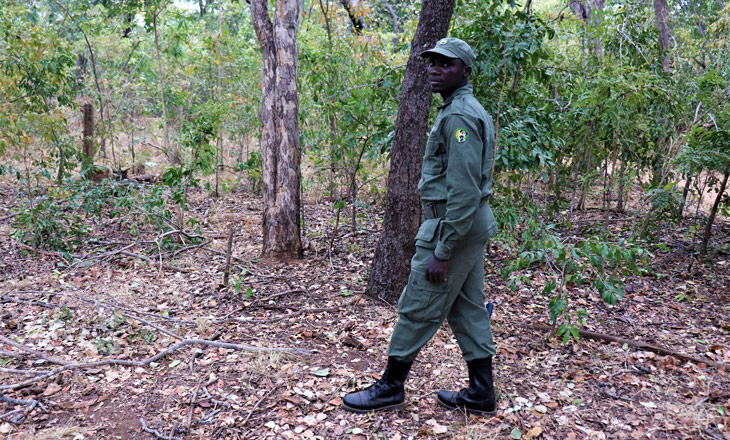
35 year old António has been a ranger for 14 years, and he has worked in the Niassa Special Reserve (REN) for the past 8 years. His work at REN has been marked by leadership in the fight against poachers from Tanzania.
António was nominated for an award from the Dr. Carlos Lopes Pereira Fund, because of the various activities he led despite the challenges. His greatest challenge was his active participation in an operation to pursue poachers who had come from Tanzania, Together with his colleagues he walked for 29 kms under difficult conditions. His bravery also contributed to obtaining good results in operations against logging within the Niassa Special Reserve and its buffer zone.
Recognition by the Rangers’ Support Fund is a great incentive to continue the inspection activities undertaken by António and others. “I feel very honoured by the award. The prize gives extra strength so that I and other colleagues remain committed to the protection of biodiversity”.
António is a source of inspiration for his colleagues. He is known as a motivated and courageous man, willing to undertake dangerous patrolling missions.
Professionals of the Conservation Areas take part in a course for tourist guides in South Africa
This is a capacity building exercise under objective 1 of the Mozambique Conservation Leadership Programme (PLCM), which seeks to strengthen the skills of the professionals of the National System of Conservation Areas (SNAC). It is taking place in the Southern Africa Wildlife College, in South Africa, and lasts for two (2) months.
Seven professionals from the SNAC are taking part, including one from the private sector and five from the public sector, namely: Talento Luwemba (ranger from Safaris de Moçambique), Gabriel Froi (ranger from the Limpopo National Park), Ussene Abdula (Tourism Officer from the Bazaruto Archipelago National Park), Rodolfo Cumbane (Ecologist at the Maputo Special Reserve), Isolda Chaúque and Shelzia Muchanga, who are both from the National Administration of Conservation Areas (ANAC).
Armindo Araman, Director of Conservation Services at ANAC, stresses that the course will help promote environmental education based on tourism activities aimed at various sectors of the public. “It is necessary to have a team that is trained to interpret, not only biodiversity, but also the communities living around the Conservation Areas”, says Araman, encouraging the beneficiaries to dedicate themselves effectively to the course activities.
The costs of the course and the accommodation of the selected professionals are supported by BIOFUND through the PLCM with finance from the World Bank. After the end of the course, it is expected that the participants will be able to play a preponderant role in promoting cultural heritage, identifying nature-based tourist attraction potential, and leading their work teams on the ground.
For more information about the PLCM and its beneficiaries, click here
BIOFUND committed to building a new generation of conservation leaders
The new Chairperson of the Board of Directors of the Foundation for the Conservation of Biodiversity (BIOFUND), Narciso Matos, in early August accompanied the activities of the interns of the Mozambique Conservation Leadership Programme (PLCM) in Luwire, in the Niassa Special Reserve.
The BIOFUND Chairperson, accompanied by the Programme Director, Alexandra Jorge, had a meeting to accompany the activities of the two interns of the PLCM Internship Programme, Zabiro Malua and Dadzie Tarua, recently trained in Sociology and Development Engineering respectively, as part of the visit he recently made to the Niassa Special Reserve.
The interns have been placed within the programme to mitigate the conflict between humans and wildlife, in which they have supported the community management team of Luwire – Lugenda Wildlife Reserve, in the work of raising the awareness of communities about how to minimise the risks of human/wildlife conflict, warning of the need for people to avoid travelling alone, and to remain alert to the signs of the presence of wild animals and how to avoid direct confrontations.
During the conversation, the interns stressed the challenges and experience acquired during the internship. “It’s a challenge to live in a Conservation Area without access to the mobile phone network, and to have to remain always alert to wild animals. However, it is a great learning experience to work in this reality with different rules and methods of work. Despite the challenges, we are motivated!”, said one of the interns.
The supervisors of the activities, Ildo António Augusto and Laura Perry, stated that the great challenge has been communicating in English with the interns, as well as the great responsibility of working with young people, since they cannot be left alone to obtain the capacity to work independently. On the other hand, the youths bring a new dynamic to the team, which is very healthy and much appreciated.
The commitment of BIOFUND (through the MozBio2 project, financed by the World Bank) to training the conservation leaders of the future has been noteworthy, and in this second edition of the internship programme, the PLCM now has a total of 57 beneficiary interns who are developing various skills within institutions linked to the conservation of biodiversity and in the public and private Conservation Areas throughout the country.
This meeting took place as part of the visit to the Niassa Special Reserve, on the occasion of the celebrations of World Ranger Day, which also served to accompany the biodiversity conservation activities undertaken by Luwire – Lugenda Wildlife Reserve, a private Conservation Area, benefitting from BIOFUND in paying wages to the rangers, through the BIO-Emergency Fund, in the context of the Covid-19 crisis.
BIOFUND and partners carry out studies on the charcoal value chain in the Licuáti Forest Reserve and Surrounding Area
The Foundation for Biodiversity Conservation (BIOFUND), in the framework of Biodiversity Offset Program, implemented with the financial support of the World Bank/Project MozBio2 and UNDP/BIOSFAC in partnership with the Wildlife Conservation Society (WCS), the National Directorate Environment (DINAB) and the National Directorate of Forests (DINAF), is implementing pilot projects to improve habitats of Maputo Special Reserve (REM) and in the Licuáti Forest Reserve (RFL), both recently declared as Key Biodiversity Areas ( KBAs) or Important Biodiversity Areas at global level. These projects aim to test the technical and financial feasibility of biodiversity offsets in Conservation Areas and in Forest Reserves in Mozambique.
In this context, the BIOFUND has been co-financing since July this year, research about Socio-Economic and Environmental Characterization of the Charcoal Value Chain in the Licuáti Forest Reserve and Surrounding Area, carried out by Filipa Zacarias, a Phd student from University of Lisbon. This study, scheduled to end in October 2021, will provide background information on the charcoal value chain in RFL, impacts of charcoal production on the income of families in Djabula community and the impact of this activity on community development and in biodiversity conservation in that region. This research will also contribute to the design of strategies for sustainable exploitation of forest resources and in biodiversity conservation in RFL as well as the design of a restoration plan.
Biodiversity offsets are the last step in the mitigation hierarchy and represent a contribution to harmonizing economic development and biodiversity conservation in Mozambique through the reduction of anthropogenic impacts, protection and restoration of biodiversity and its ecosystem services.
Ranger of the year 2021 - Martins Rodrigues: Inspection work requires strength and patience
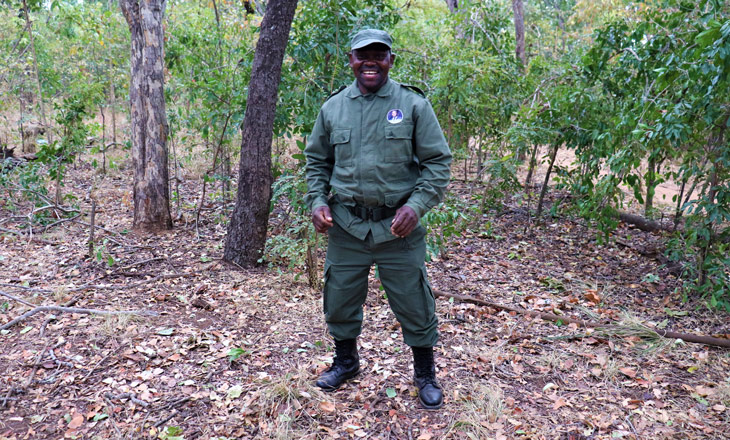
Martins Rodrigues is 54 years old, and has worked as a Ranger for 9 years. He works in the Maputo Special Reserve (REM), and he has become prominent in reducing poaching in the southern region of the REM.
Martins entered the inspection area in 2012. That was when he became passionate about nature and the need to protect natural resources. Due to his determination and commitment, Martins Rodrigues currently holds the post of head of inspection of the southern region of the Maputo Special Reserve.
According to Martins, the Dr. Carlos Lopes Pereira Fund has recognised the effort and commitment of the Rangers of the REM in fighting against poaching and reducing the smuggling of goods from South Africa into Mozambique and vice-versa. “This award is a great recognition that makes me believe that the work done is not in vain and that I am contributing to objectives of the conservation of biodiversity. I congratulate my colleagues, because the work was collective”.
During his inspection activities, Martins has faced various challenges, notably death threats from poachers. Despite these threats he remains firm and determined to continue his work, and advises all rangers to be true heroes of biodiversity, because inspection work requires strength and patience.
Watch out for coming publications, and know the stories of the other 3 Rangers granted awards by the Dr. Carlos Lopes Pereira Fund.
Ranger of the year 2021 - João Bernardo Castigo Massane: “To be a ranger is to guarantee that natural resources exist for future generations”
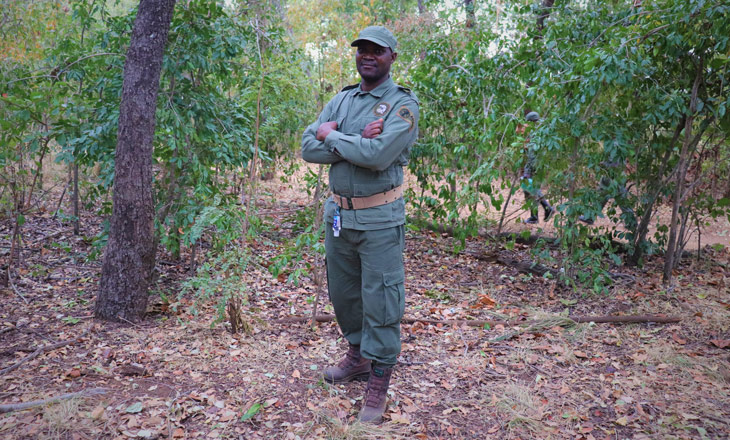
João is a Ranger at the Bazaruto Archipelago National Park. He is 37 years old and has been a ranger for 18 years. He became prominent in blocking the wave of illegal night fishing, through neutralising illegal fishermen and their boats.
His passion for the conservation of biodiversity arose as a child when he watched a sea turtle being taken from the net by fishermen. According to João, the turtle was in tears because it was being taken from its habitat. He found this scene very moving, and as from that moment he decided to protect the marine biodiversity which was at risk of disappearing.
João Massane had two outstanding moments which contributed to his nomination as Ranger of the Year 2021. The first happened in 2011 when he neutralised 6 illegal fishing boats and helped in the detention of 45 offenders. The other mark in João’s career came in December 2020 when he led a night patrol which culminated in the neutralisation of 3 illegal fishing boats and the detention of 18 offenders.
João is pleased at his nomination as one of the Rangers of the Year for 2021 by the Dr. Carlos Lopes Pereira Fund, and he is ready for new challenges. “This recognition is the result of a collective effort which has brought positive results. I feel honoured and I have gained new strength to protect the environment”.
In the context of the celebrations of World Ranger Day, João leaves a message for all forestry and wildlife rangers. “To be a ranger is to guarantee that the natural resources exist for future generations”.
Watch out for coming publications, and know the stories of the other 4 Rangers granted awards by the Dr. Carlos Lopes Pereira Fund.
12 August: World Elephant Day
World Elephant Day is celebrated on 12 August. The date was created with the main objective of preserving this animal, which, although it is the largest land mammal on the planet, is vulnerable because of attacks by poachers.
In this context, in the forest of the Niassa Special Reserve, President Filipe Nyusi recently named the new leader of a herd of elephants in that Conservation Area, by attaching a satellite monitoring collar.
This was an operation which initially was intended to change the collar on another elephant, known as “Mr President”, placed by Nyusi in 2018. But this proved imposable because that elephant was in dense forest and could not be located.
While “Mr President” was taking refuge in the forest, his brother was nearby, following all the movements. So President Nyusi, accompanied by the First Lady, Isaura Nyusi, put the satellite monitoring collar on the brother of “Mr President” whom he named “The Gentleman”, as the new leader of the herd. According to President Nyusi, “The Gentleman” took on the leadership of the group in the absence of his brother.
This act took place as part of the ceremony marking World Ranger Day at the head office of the Niassa Special Reserve (Mbatamila), in Mecula district, Niassa province, and is one of the efforts made to protect elephants in our beautiful Mozambique. The ceremony was organized by the National Administration of Conservation Areas (ANAC), the Wildlife Conservation Society (WCS), the Foundation for the Conservation of Biodiversity (BIOFUND) among other conservation partners.
Dr. Carlos Lopes Pereira Fund grants awards to five conservation rangers
This was the first award by the Dr Carlos Lopes Pereira Fund (formally set up in July 2020), at an event marking World Ranger Day, which is commemorated every year on 31 July. This year the ceremony was held in the Niassa Special Reserve, and was chaired by President Filipe Nyusi. The winners were chosen after a rigorous selection process held between 11 June and 5 July this year, when the administrators/managers of various Mozambican Conservation Areas submitted the candidacies of the Rangers who had stood out most over the previous year.
13 applications were received for the Ranger of the Year Award 2021. They were assessed by an independent jury, consisting of the Foundation for the Conservation of Biodiversity (BIOFUND), the National Administration of Conservation Areas (ANAC) and the Mozambican Association of Safari Operators (AMOS), who determined the five winning Rangers, based on the following criteria:
- Commitment and dedication – referring to an expression of enthusiasm and competence to work as a Ranger, carrying out all the daily duties in an exemplary manner.
- Impact and contribution – referring to the significant contribution to the protection of fauna and habitats, promoting conservation in the local communities or other work essential for conservation.
- Threats and challenges overcome – referring to skills in responding courageously to the difficulties and dangers faced at work: dealing effectively with the challenges of combatting damage to wildlife.
- Leadership and inspiration – referring to the capacity to comply with the expectations of their duty, demonstrating the ability to influence, motivate and lead the members of the team.
The five winning rangers of 2021 are from five Mozambican public and private conservation areas, namely: António Soze Fombe of the Niassa Special Reserve, João Bernardo Castigo Massane of the Bazaruto Archipelago National Park, José Ernesto Amimo of Luwire – Lugenda Wildlife Reserve, a private operator that is part of the Niassa Special Reserve, Martins Rodrigues of the Maputo Special Reserve, and Talento Luwemba of Safaris de Moçambique, in Tchuma Tchato. Each winning ranger received a diploma of merit, and the sum of 25,000 meticais in money.
The Dr. Carlos Lopes Pereira Fund has ANAC and AMOS as its main partners, and its main donors are BIOFUND, TUSK and AVM Consultants.
For more information about the Dr. Carlos Lopes Pereira Fund, visit the BIOFUND website, through the link https://www.biofund.org.mz/projects/apoio-aos-fiscais/
President Nyusi praises the importance of the Biodiversity Exhibition organised by BIOFUND
This information was announced on 31 July 2021, during an event celebrating World Ranger Day, organised by the National Administration of Conservation Areas (ANAC), in the Niassa Special Reserve, after the Mozambican President, Filipe Nyusi, had visited the Biodiversity Exhibition developed by the Foundation for the Conservation of Biodiversity (BIOFUND).
The main purpose of the exhibition was to highlight the courage of the forestry and wildlife rangers, making the participants aware about their role in the protection of the rich biodiversity of our country, and reached about 100 people.
In this context, photographs and panels on biodiversity were exhibited, with relevant information on species of flora and fauna and habitats, which are predominant in the Niassa Special Reserve, as well as photographs of rangers during their activities, and handicrafts made by the local communities.
During the visit, the President was impressed with the work undertaken by BIOFUND around the promotion and conservation of biodiversity, and by the local community initiatives. “It’s gratifying to see private organisations such as BIOFUND committed to protecting the environment. Furthermore the communities are playing an important role in looking for local alternatives to generate income. The exhibition illustrates the excellent work being done to protect the natural resources and to develop the communities”, stressed Filipe Nyusi
BIOFUND has been holding the Biodiversity Exhibition since 2015 and it has already reached more than 15,000 people and 120 schools in five Mozambican provinces (Maputo, Gaza, Inhambane, Manica and Zambézia).
The Niassa Special Reserve, which hosted the event, is the largest Conservation Area in Mozambique, covering about 42,400 Km2, including its buffer zone. It is one of the largest Miombo Forest reserves in the world, which shelters very significant wildlife populations and an immeasurable variety of the country’s biological diversity. This area benefits from BIOFUND through the BIO-Emergency Fund, which supports the payment of wages to rangers (whose wages were previously paid through income from tourists) and in acquiring COVID 19 prevention material, during the period of the pandemic.
International Day of Forestry and Wildlife Ranger marked by the distinction of five rangers of 2021
The recognition was granted by Mozambican President Filipe Jacinto Nyusi at a ceremony held in the Niassa Special Reserve, on 31 July 2021, World Ranger Day,
Celebrated in 2021 under the slogan “I am with the rangers of the entire world”, the event was attended by the President of the Republic, the Minister of Land and Environment, the Governor and Secretary of State of Niassa, the General Director of the National Administration of Conservation Areas (ANAC), the Chairperson of the Board of Directors of the Foundation for the Conservation of Biodiversity (BIOFUND), a representative of the Mozambican Association of Safari Operators (AMOS) and other figures from the conservation sector. Also participating in the event was the Minister of Devolution and of Arid and Semi-Arid Lands of the Republic of Kenya, representing the Kenyan President, Uhuru Kenyatta.
At this event, among other highlights, 5 (five) rangers were distinguished from 5 of the country’s public and private conservation areas, namely António Soze Fombe from the Niassa Special Reserve, João Bernardo Castigo Massane from the Bazaruto Archipelago National Park, José Ernesto Amimo de Luwire, of the Lugenda Wildlife Reserve, a private operator that is part of the Niassa Special Reserve, Martins Rodrigues of the Maputo Special Reserve, and Talento Luwemba of Safaris de Moçambique, in Tchuma Tchato. These awards were granted in the framework of the first edition of the Dr. Carlos Lopes Pereira Fund, a fund set up in 2020 by Dr. Carlos Lopes Pereira, Director of the Protection and Inspection Services in ANAC, as a result of the prize awarded to him by Tusk and managed by BIOFUND, which seeks to recognise and exalt the courage of the rangers of the public and private Conservation Areas.
On the occasion, the President of the Republic highlighted the role that rangers play in protecting the biodiversity of our country. “In the name of all Mozambicans, I congratulate all the rangers, and particularly the rangers honoured here. I would like them to serve as a model and source of inspiration for the other colleagues who are working to protect flora and fauna. This celebration seeks to applaud the role of the rangers on the front line, who have lost their lives in the defence of conservation. The celebration is not only for the rangers of the public Conservation Areas but also for those in the private areas who dedicate themselves to the protection of nature”, said President Nyusi.
Speaking after he received his award, Martins Rodrigues, of the Maputo Special Reserve, declared “I feel very honoured to represent the rangers of all the Conservation Areas, and of my Conservation Area in particular. This award gives us more strength to continue working for the protection of natural resources.”
The event had other conservation activities, notable the Exhibition on Biodiversity organised by BIOFUND in the open air and the placing of a satellite monitoring collar on an elephant, nicknamed “The Gentlemen”, by the President of the Republic.
Pay attention to our page and learn more about the other activities undertaken in the Niassa Special Reserve, in the context of the celebrations of World Ranger Day.
PLCM interns train staff of the National Forestry Directorate in the design and management of data bases
Eight staff members of the National Forestry Directorate have benefitted from building their capacity in designing and management of data bases, through the tools of Advanced Excel This training took place from 20 to 23 July, and was led by interns of the Conservation Leadership Programme of Mozambique (PLCM). During the sessions, which took place at the headquarters of the National Forestry Directorate in Maputo, the staff had the possibility of perfecting their skills so as to improve their performance during their day-to-day activities.
The participants in the course were the Department Head of the Forestry Information System, the General Support Department Head (Department of Human Resources), staff of the Department of Norms and Control, and staff of the Department of Community Management.
During the training, several examples were presented aimed at the daily activities of the DINAF staff, focusing on the use of the tools for the design of data bases for the management of processes and verification of the compliance of activities, and tools for the design of data bases for the historical assessments of data.
According to the staff, this training was extremely important because they were having difficulties in the use of the Excel tool and it is hoped that this course could cover other staff who are working in other provincial directorates.
For the intern Matola Salimo, who holds a master’s degree in Management and Conservation of Biodiversity from the Eduardo Mondlane University, this course is part of the internship plan, and this sharing of knowledge is a great opportunity to improve, not only the skills of the DINAF staff, but is mainly a way of implementing specific activities in the work of the National Forestry Directorate.
BIOFUND signs subvention agreement to start community development activities in the Gilé National Park

This is an agreement signed between the Foundation for the Conservation of Biodiversity (BIOFUND) and the Network for Environment and Sustainable Community Development in Zambézia (RADEZA), in the framework of the PROMOVE Biodiversidade programme, with financing from the European Union, to the sum of 792.000,00 (seven hundred and ninety two thousand) Euros, for the implementation of community development activities in the buffer zone of the Gilé National Park (PNAG) up to 2025.
With this intervention, it is expected to strengthen the organizational capacity of the Nokalano Association, the strategic partner for making operational the Mulela Community Game Reserve, set up under Decree no. 43/2013 of 23 August, promote environmental awareness raising activities among the communities, disseminate the practices of sustainable economic activities with the use of improved agricultural production systems, strengthen the participation of the local communities in decision making, and establish sustainable means of generating income, in order to reduce the pressure on the natural resources of the PNAG.
The main objective of the PROMOVE Biodiversidade programme is to protect biodiversity and contribute to improving the livelihoods of the rural communities through the sustainable management of natural resources. The programme also envisages strengthening the capacities of the institutions that deal with natural resource management, implementing sustainable initiatives and strategies that improve the management and administration capacity of the areas of intervention of the project, adopting sustainable livelihood practices for the local communities living in the interior and the buffer zones of the Conservation Areas, and encouraging the dissemination of applied research and participatory studies to influence natural resource management.
The programme is implemented by BIOFUND and ANAC, and its beneficiaries are the Gilé National Park, the First and Second Islands Environmental Protection Area and Mount Mabu. For more information about the PROMOVE Biodiversidade programme click here
Mangroves: Eco-systems indispensable for living beings and for nature
The International Day for the Conservation of the Mangrove Ecosystem was celebrated on 26 July, under the motto “Mangroves restored, Mozambique resilient”. The mangroves are unique, highly productive and complex forests that develop in zones of transition between the terrestrial and marine environment in tropical and sub-tropical areas.
The mangroves are extremely important for living beings and for nature, because they provide a series of ecosystem services, such as a nursery for the reproduction of various marine species, coastal protection against strong winds and sequestration of carbon, contributing to the mitigation of climate change.
Mozambique has the 13th largest coverage of mangrove forests in the world and the 3rd largest in Africa with about 300,000 hectares and 9 separate species. However, despite their great importance, the mangrove forests of Mozambique are under great pressure because of natural and anthropogenic causes, mainly due to the impact of extreme climatic events, the exploitation of wood resources and urban growth in the coastal areas.
The Ministry of the Sea, Inland Waters and Fisheries (MIMAIP) and its various partners, including the Foundation for the Conservation of Biodiversity (BIOFUND), the World Wide Fund for Nature (WWF), the National Sustainable Development Fund (FNDS), and ProAzul, among others, joined on 26 July for the launch of the National Programme for the Restoration of the Mangrove Eco-system with the objective of publicizing the Mangrove Management Strategy (2020 – 2024), guiding management and restoration measures at national level, and increasing the awareness of of Mozambican society about the importance of the mangroves.
Through its programmes, BIOFUND has participated actively in the development of the National Mangrove Strategy. It promotes the creation of knowledge about the mangroves through the development of metrics to assess the condition of the mangroves, makes civil society aware of their ecological and socio-economic importance, and supports their protection in all the country’s marine conservation areas.
Watch the video of the Launch of the National Programme for the Restoration of the Mangrove Eco-system by clicking here.
Webinar for the Presentation of the ROAM Tool
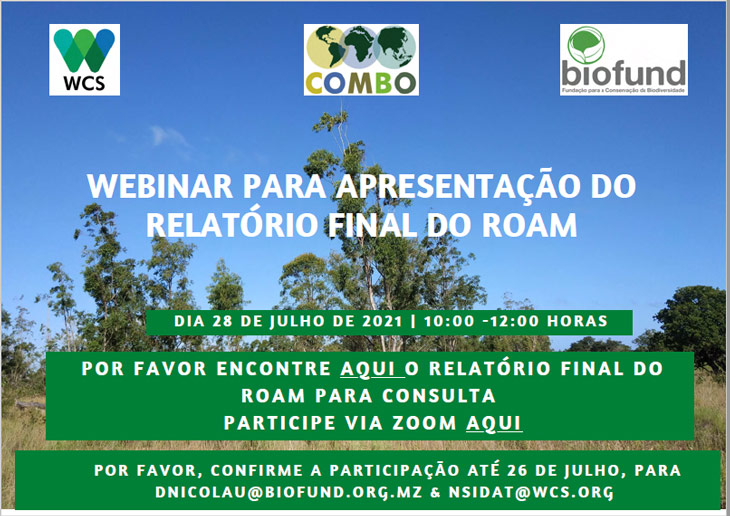
The Foundation for the Conservation of Biodiversity (BIOFUND) and the Wildlife Conservation Society (WCS), through the COMBO Project, are holding this Wednesday, 28 July, from 10:00 to 12:30, a webinar to present the final report of the tool for assessing biodiversity restoration priorities in Mozambique.
This initiative began in January of the current year and has already included two field visits for on-site data validation, bringing together more than 50 specialists from government, civil society, academia and the private sector at the national level.
To participate in the event, click on the invitation link:
https://zoom.us/j/97036760446?pwd=NmRIVGZXTE1remJpYVBrdko5b3d0QT09#success
For more information, please contact dnicolau@biofund.org.mz and nsidat@wcs.org
PROMOVE Biodiversidade holds 1st meeting of National Supervisory Committee
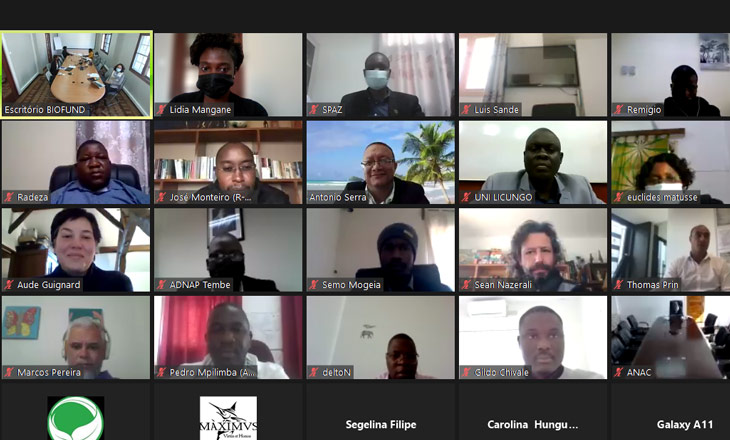
On 15 July 2021, the “PROMOVE Biodiversidade” programme held the 1st meeting of its National Supervisory Committee, at a virtual event organized by the Foundation for the Conservation of Biodiversity (BIOFUND) and the National Administration of Conservation Areas (ANAC).
About 30 members and guests participated in the event, notably from the European Union, the Office of the National Authorising Officer (GON) in the Ministry of Foreign Affairs and Cooperation, a representative of the Ministry of the Sea, Inland Waters and Fisheries (MIMAIP), Administrators of the beneficiary areas, Directors of the Provincial Environment Services of Zambézia and Nampula, programme implementing partners in the beneficiary areas, and representatives of five institutions of higher education in Nampula, Niassa and Zambézia provinces, notably the Vice-Chancellor of the Licungo University, Prof. Dr. Boaventura José Aleixo.
During the meeting, the general director of ANAC and Chairperson of the CNS, Mateus Mutemba, said that the programme will strengthen activities to conserve biodiversity in Mozambique. “PROMOVE Biodiversidade, a project resulting from an agreement signed in 2019 between the Mozambican government and the European Union, will contribute to implementing the strategy for the conservation of biodiversity in our country.”
The CNS of PROMOVE Biodiversidade is a multi-sector body, which will advise and accompany the implementers and beneficiaries in various activities undertaken in the framework of the programme and ensure alignment with national and international policies and strategies. This 1st meeting discussed and aligned the responsibilities of the committee, the activity plans, the budget and the stage of implementation of PROMOVE Biodiversidade.
The first meeting of the CNS of PROMOTE Biodiversity took place a month after the official launch of the programme in the Gilé National Park, under the slogan “We are all Biodiversity”.
PROMOVE Biodiversidade is a programme financed by the European Union and implemented by BIOFUND and ANAC, which seeks to promote the conservation of biodiversity and community development in two conservation areas and one area of high biodiversity, namely the Gilé National Park (PNAG), the First and Second Islands Environmental Protection Area (APAIPS) and Mount Mabu, in Zambézia and Nampula provinces.
Zambeze Delta Safaris sets up mechanisms to protect Biodiversity
Zambeze Delta Safaris – ZDS – in Official Game Reserve 11, in the framework of its management plan, has established, in a process of coordination with the communities, the zoning of Game Reserve 11, in order to separate the areas of settled population, in the northern zone of C11, from the hunting areas, and the areas of concentration of about 30,000 animals of 30 species and 250 varieties of birds.
With this action, it is intended to control the damage to the habitat so that the communities undertake their daily activities such as agriculture, fishing, honey production, access to fresh meat, leisure, health and education while the company ZDS ensures a high standard of conservation of the forests, savannas, rivers, lakes, swamps and animal species, keeping the landscape of Game Reserve 11 at a level of natural beauty, biodiversity and conservation of high international quality.
With these objectives, ZDS, in coordination with the community and with the support of its partners, clients and donors, is undertaking free ploughing with a tractor of 68 hectares of land in a continual strip for the production of rice and maize, the free distribution of fertiliser, the free provision of grain milling services, facilitating access to fishing by the residents, a programme to encourage the production of honey, with the free delivery of 350 beehives, and training and technical assistance for the personal income of the community.
As an impact of this action, the communities of the buffer zone registered, as their harvest for the month of May/June 2021, average productivity of rice of five tonnes a hectare. One production block reached 6.3 tonnes a hectare in a rain-fed regime.
With this community support, ZDS intends to create incentives and alternatives in the community, which discourage the practice of slash-and-burn itinerant agriculture, which is an agricultural technique involving the cutting and burning of trees and plants in forests to create fields for agricultural production. In turn, these fields often become impoverished and abandoned after a few years of use, causing the loss of natural habitats for many species of flora and fauna, which are the basis for biodiversity. This biodiversity is crucial for maintaining the ecological sustainability of the soils, water sources and nutrients. It is an important natural asset, which also lends great beauty to the natural landscape of Game Reserve 11.
ZDS is one of the oldest Conservation Areas (AC) of sustainable use in Mozambique. It is located in Marromeu district, in Sofala province, and is intended for game hunting and the protection of various species and ecosystems. This is one of the 13 privately managed ACs that are benefiting from the BIO-Emergency Fund. BIOFUND supports the game reserve in paying the wage costs of 20 rangers, in order to reduce the impact of the loss of tourism revenue during the COVID-19 pandemic and to keep a ranger force active in the field.
PLCM interns receive training in managing conflicts between people and wild life and in community development
In June, the interns of the Leadership Programme for Conservation in Mozambique (PLCM), took part in a training course on the management of conflicts between people and wild life and on community development, organised by the World Wide Fund for Nature (WWF), through the Kheta project.
The training took place in the Maputo Special Reserve (REM) and involved the participation of extensionists, representatives of WWF, the National Sustainable Development Fund, the Provincial Forestry and Wildlife Services, and members of the community living near the Conservation Areas.
The training course was given by Mike Lagrande, a representative of the Kheta project, and on the occasion, the Conservation Areas showed the techniques they use to manage the existing conflicts, focusing on the REM, which has used ropes dipped in creosote or burnt oil, bullets of chilli peppers, and spotlights to frighten off large animals. The spotlights can be used to drive away elephants, buffaloes and hippopotamus. The same is true of the ropes, mixed with chillies or burnt oil, since they give off a strong smell which ensures that the animals avoid these populated areas.
Lagrande recommended that, in the case of hippos, the paths they use when they go to their pastures should be identified, and kept open so that they return by the same route. The communities should put fences around their fields so that the hippos do not cross into them.
For António Simão and Odiela Massingue, PLCM interns stationed at the REM, this training has been of great importance because previously they only possessed theoretical knowledge about managing conflicts between people and wild life, while in practice it is necessary to find local solutions.

